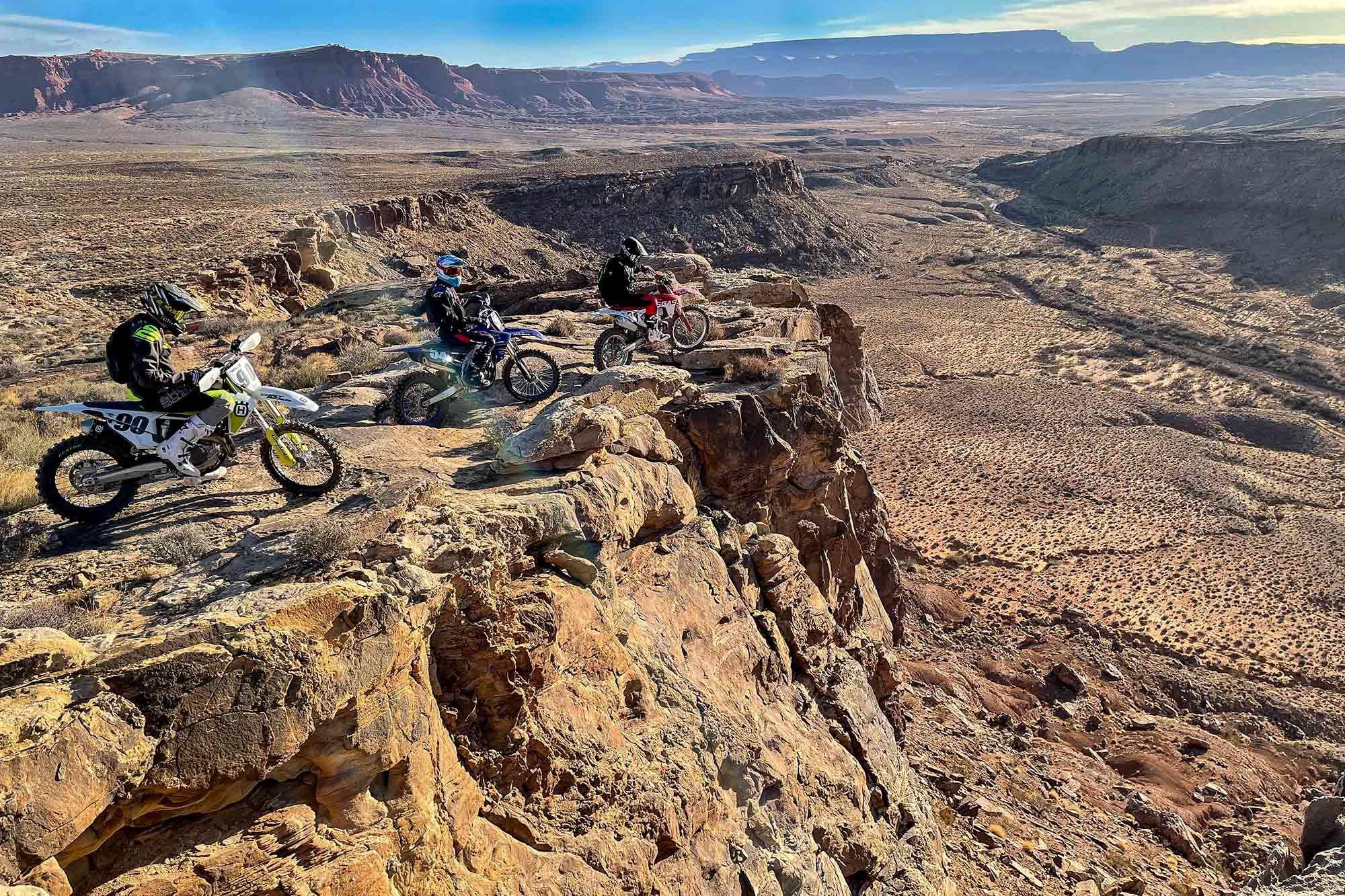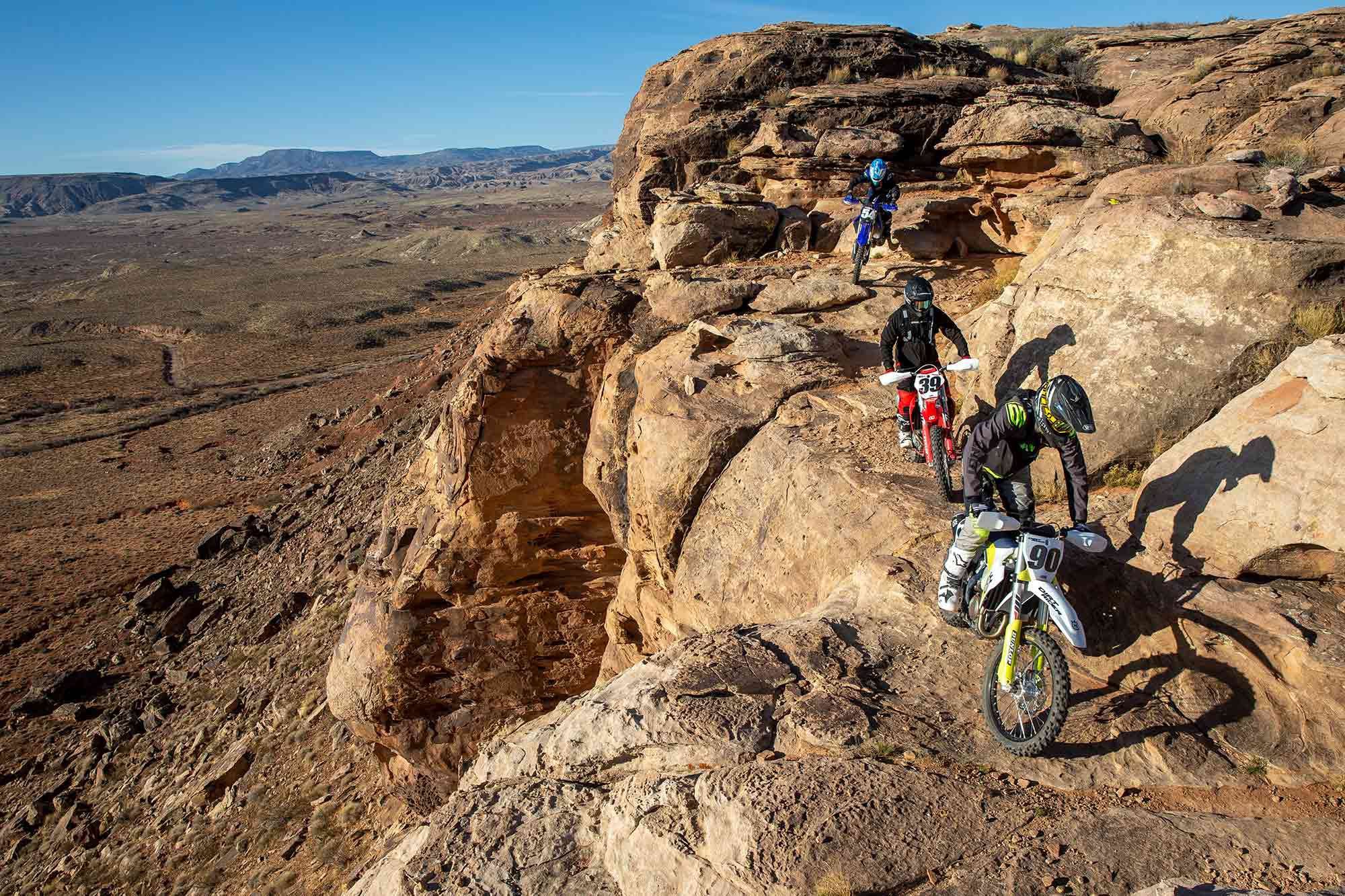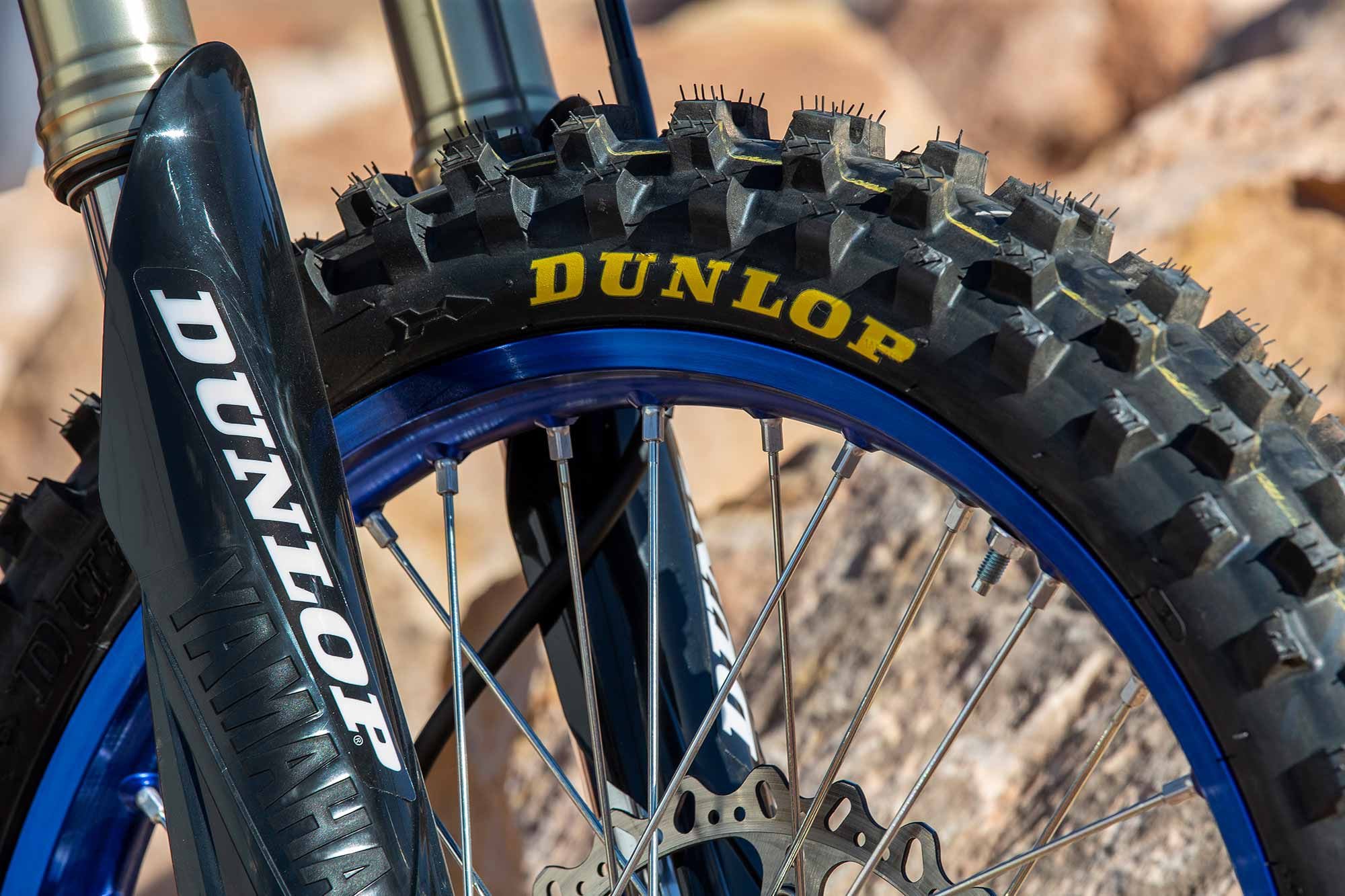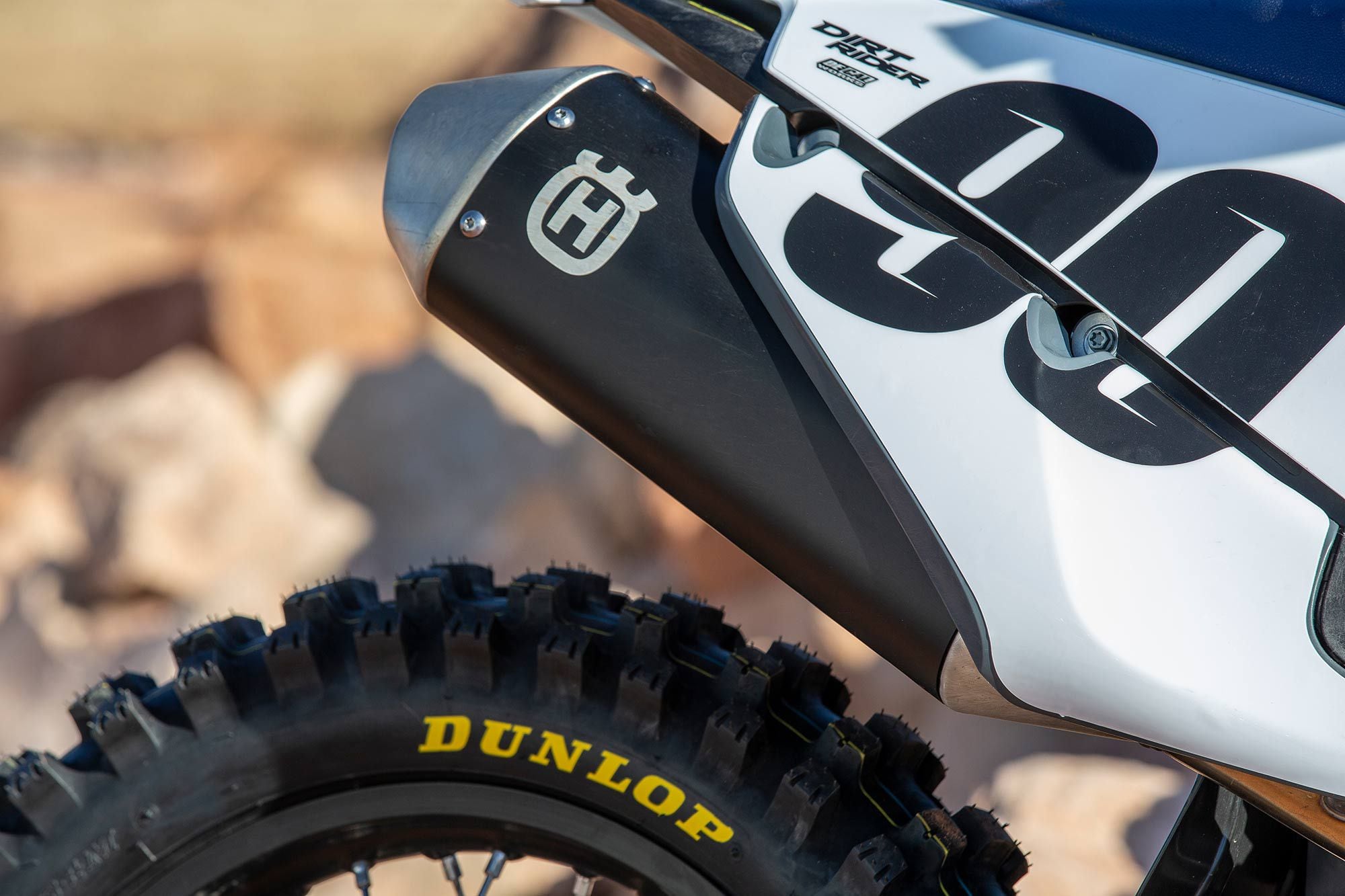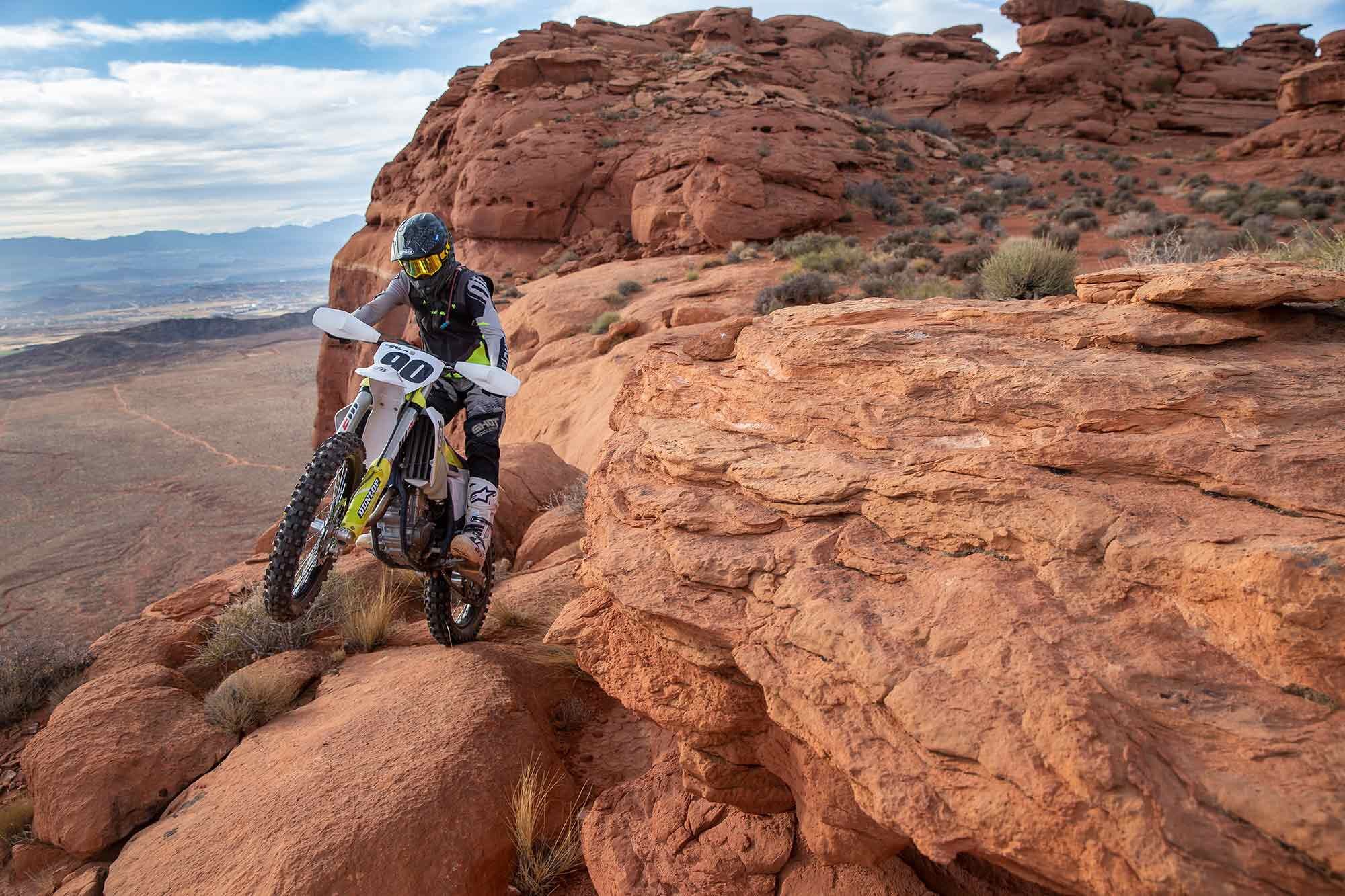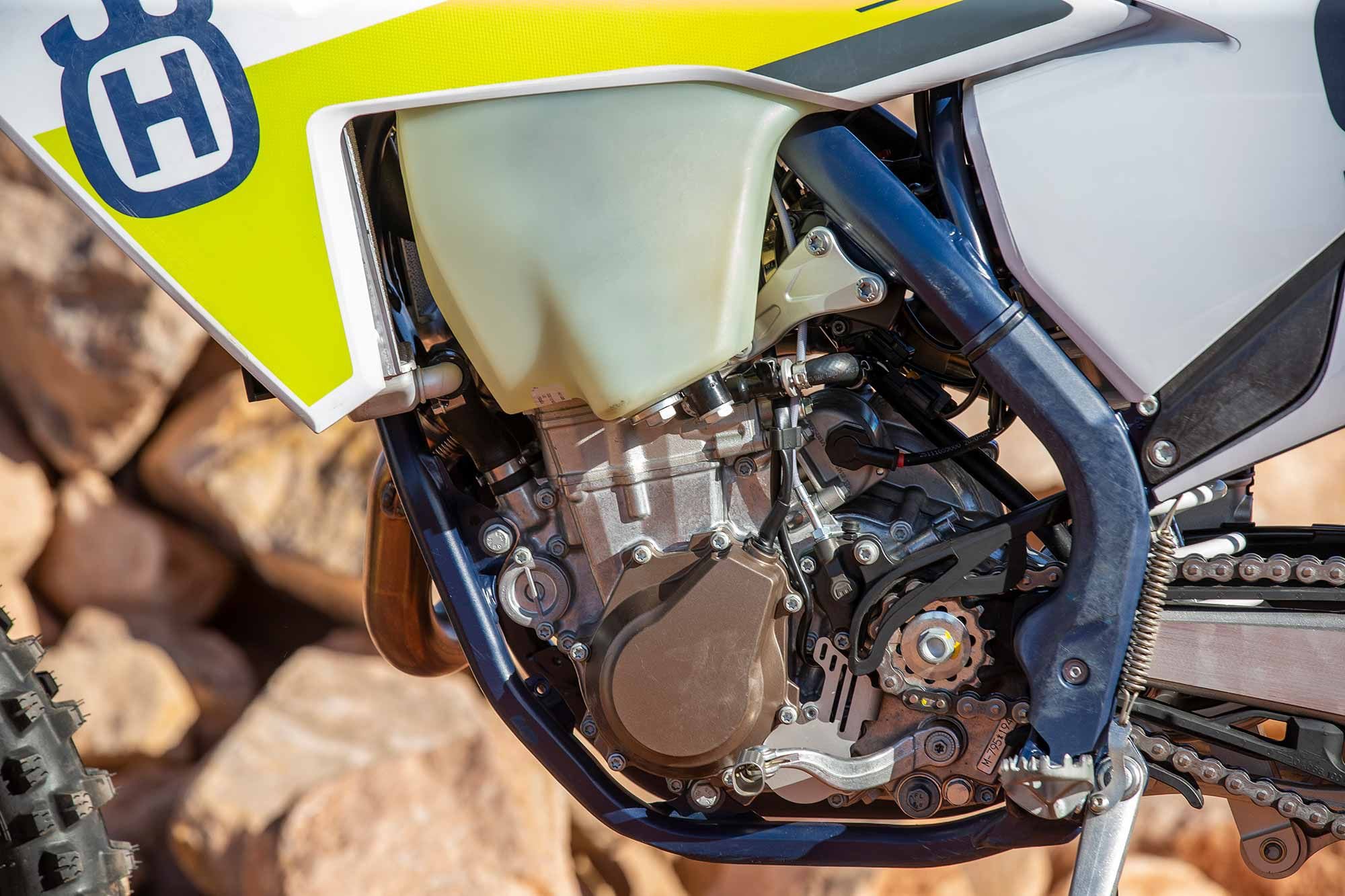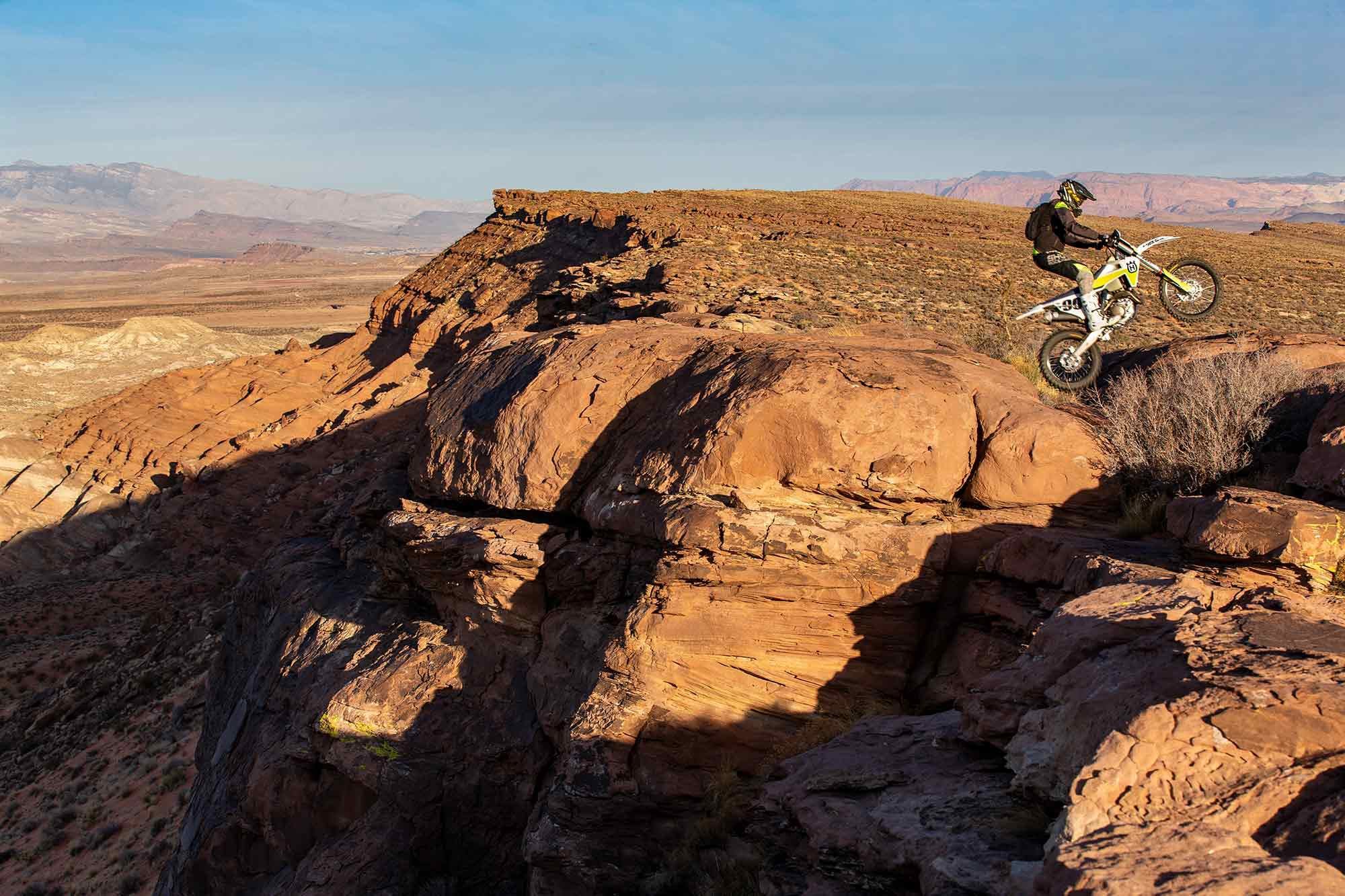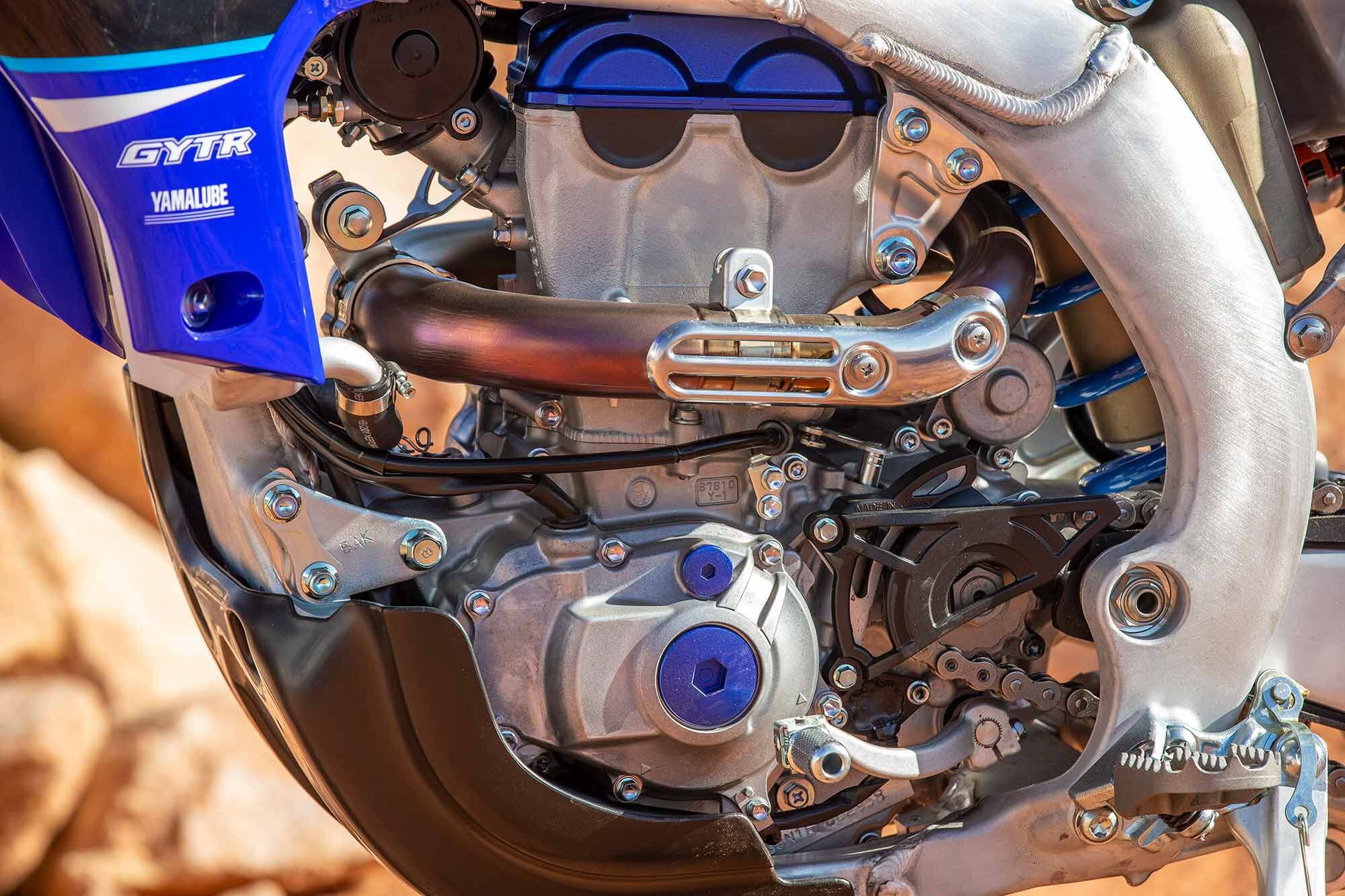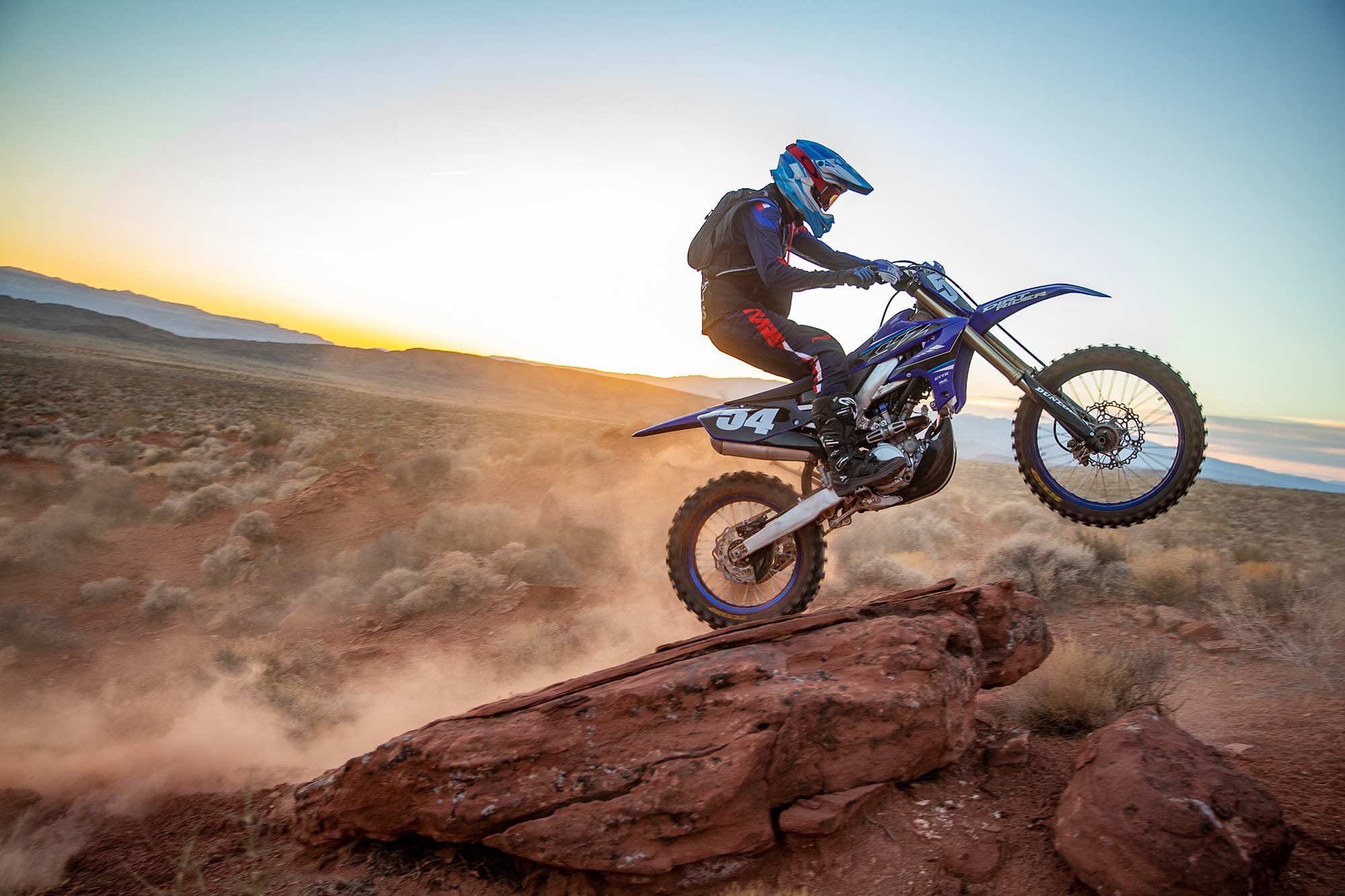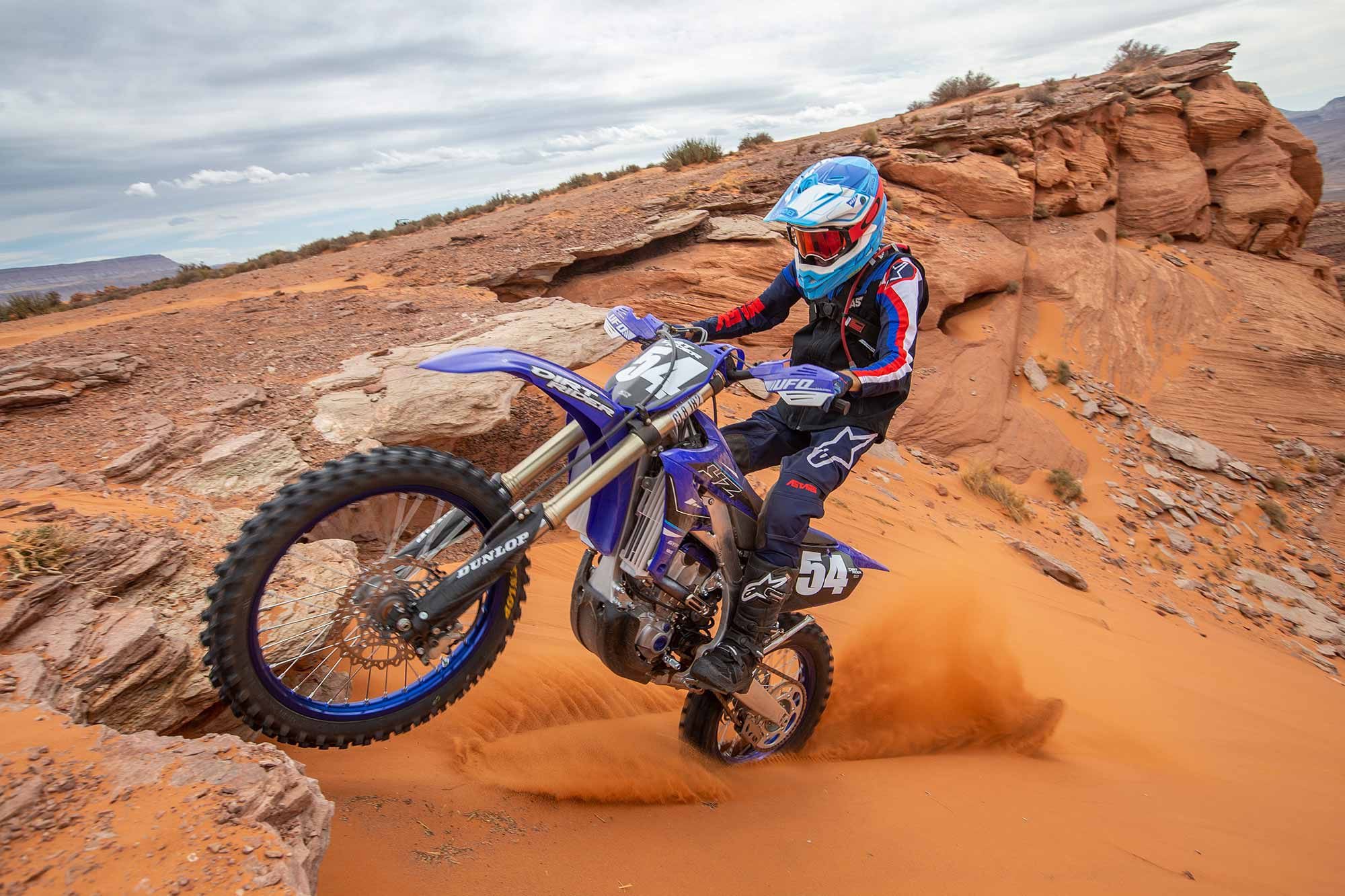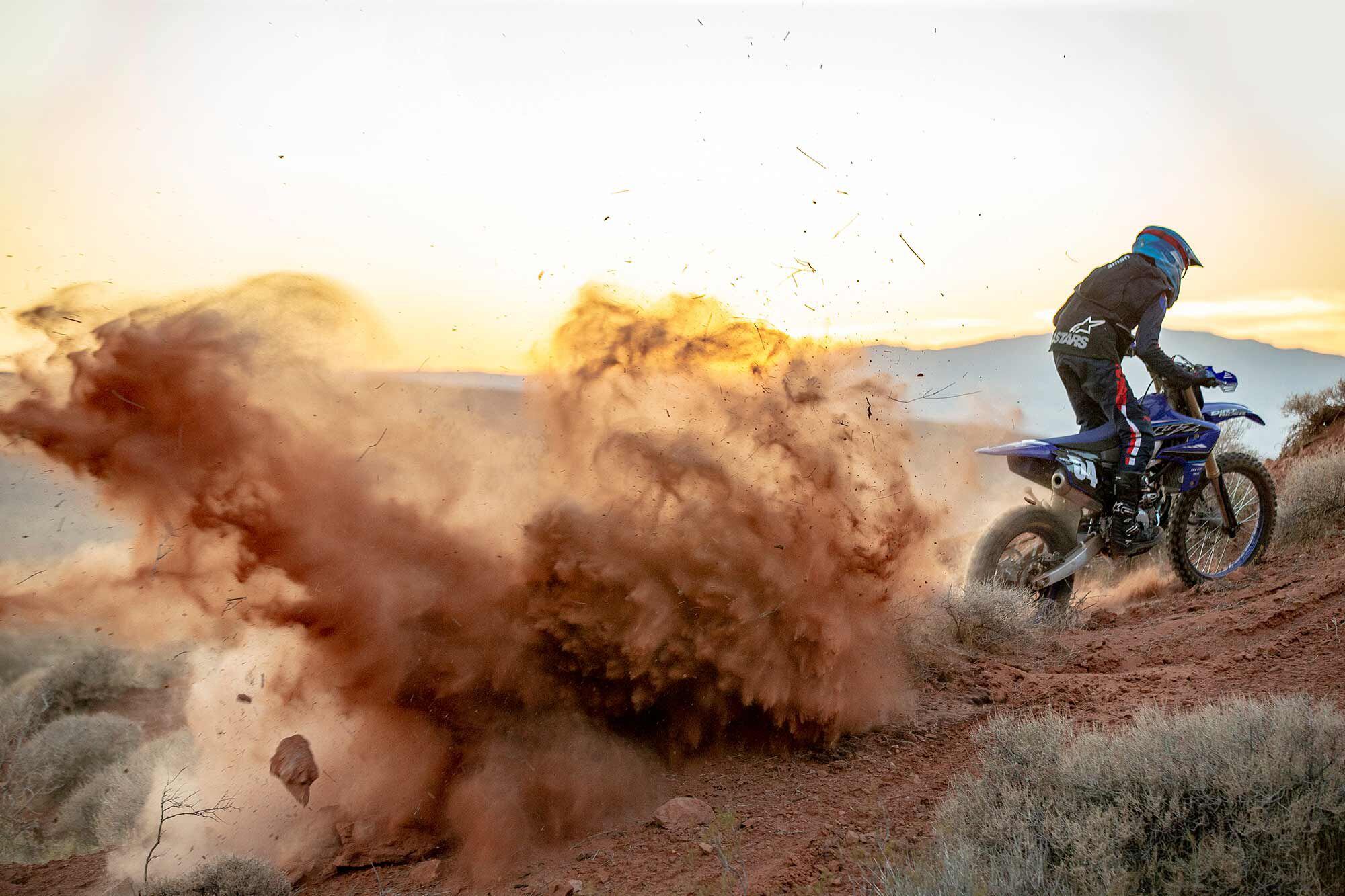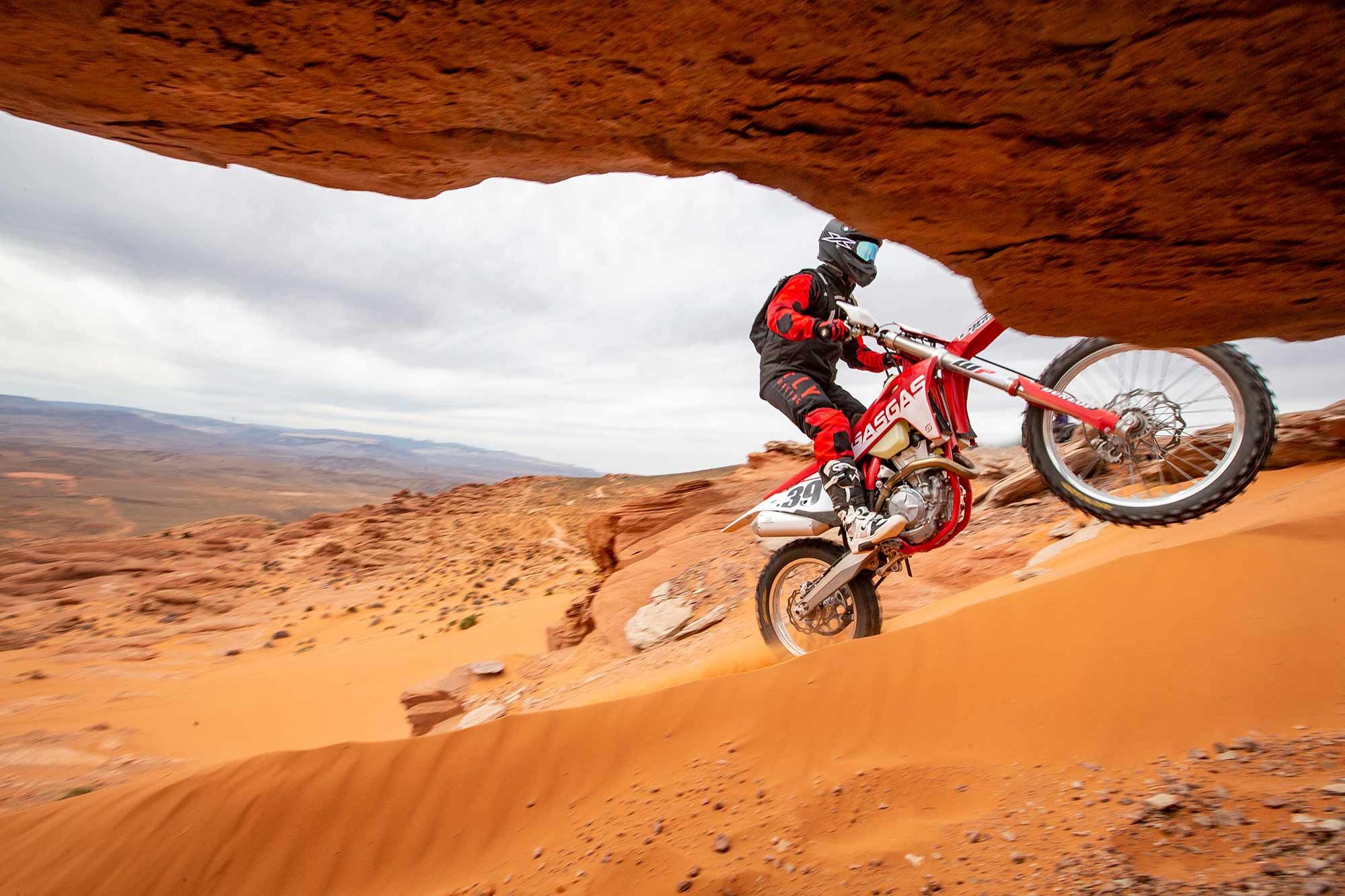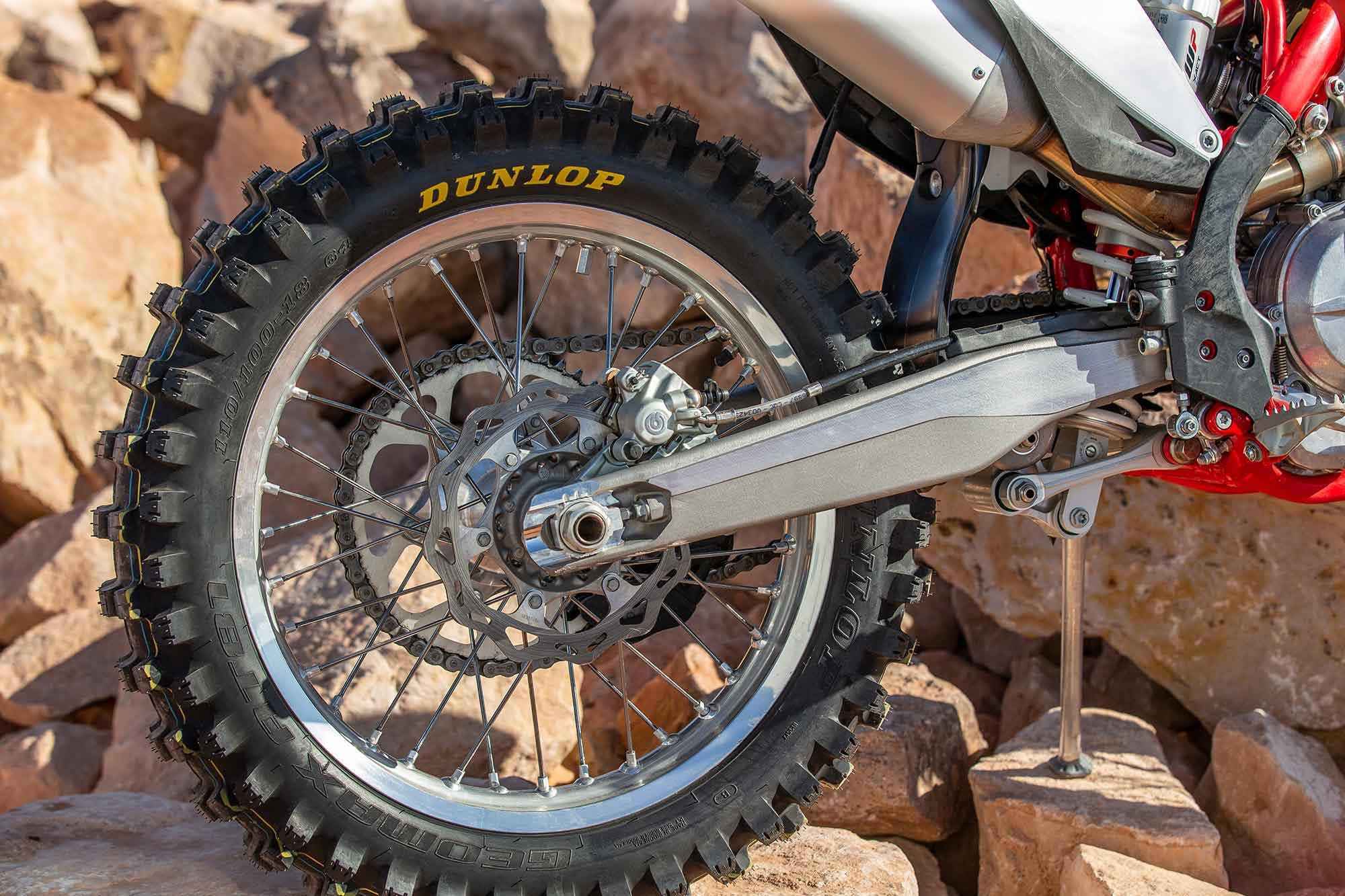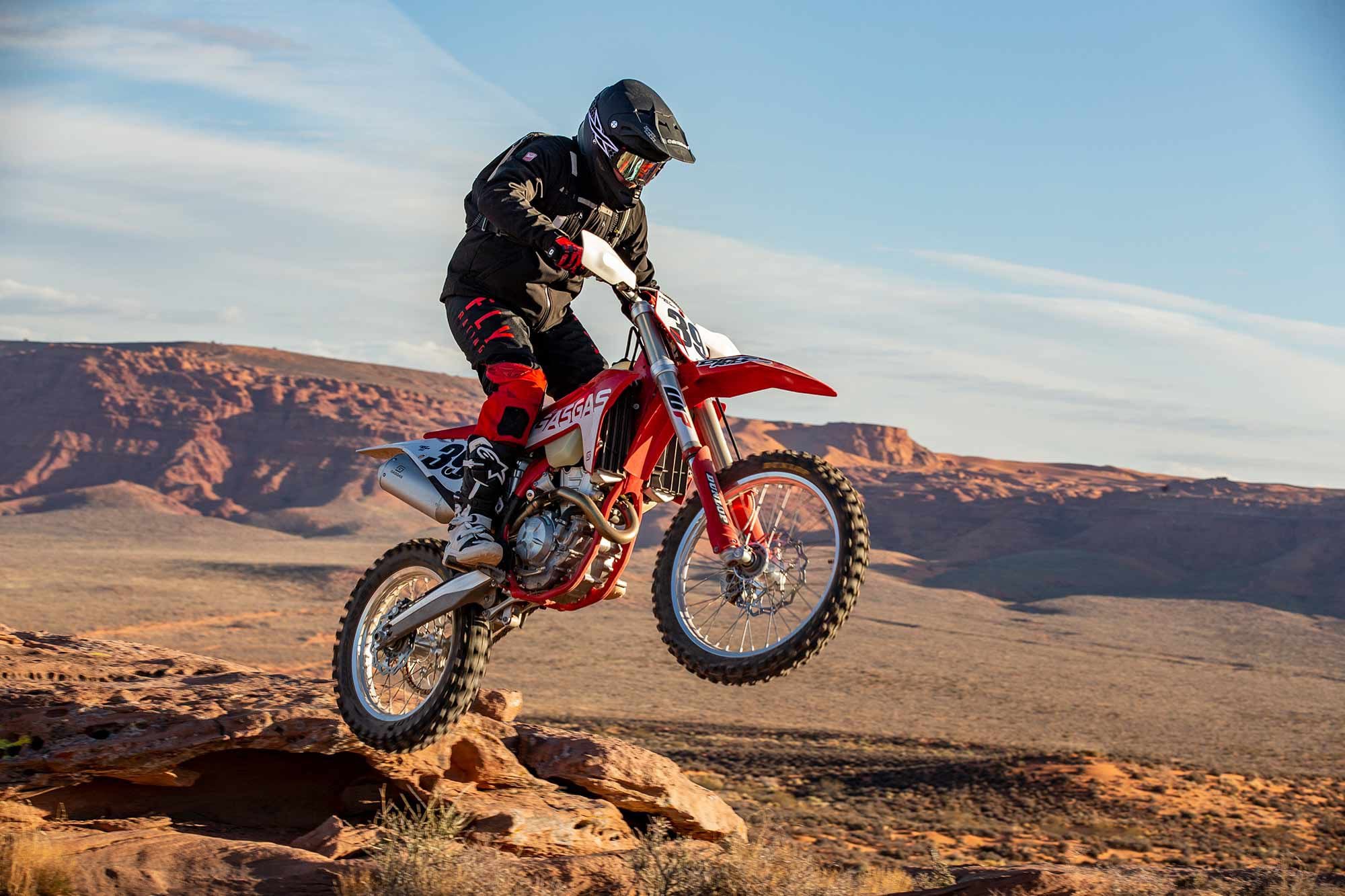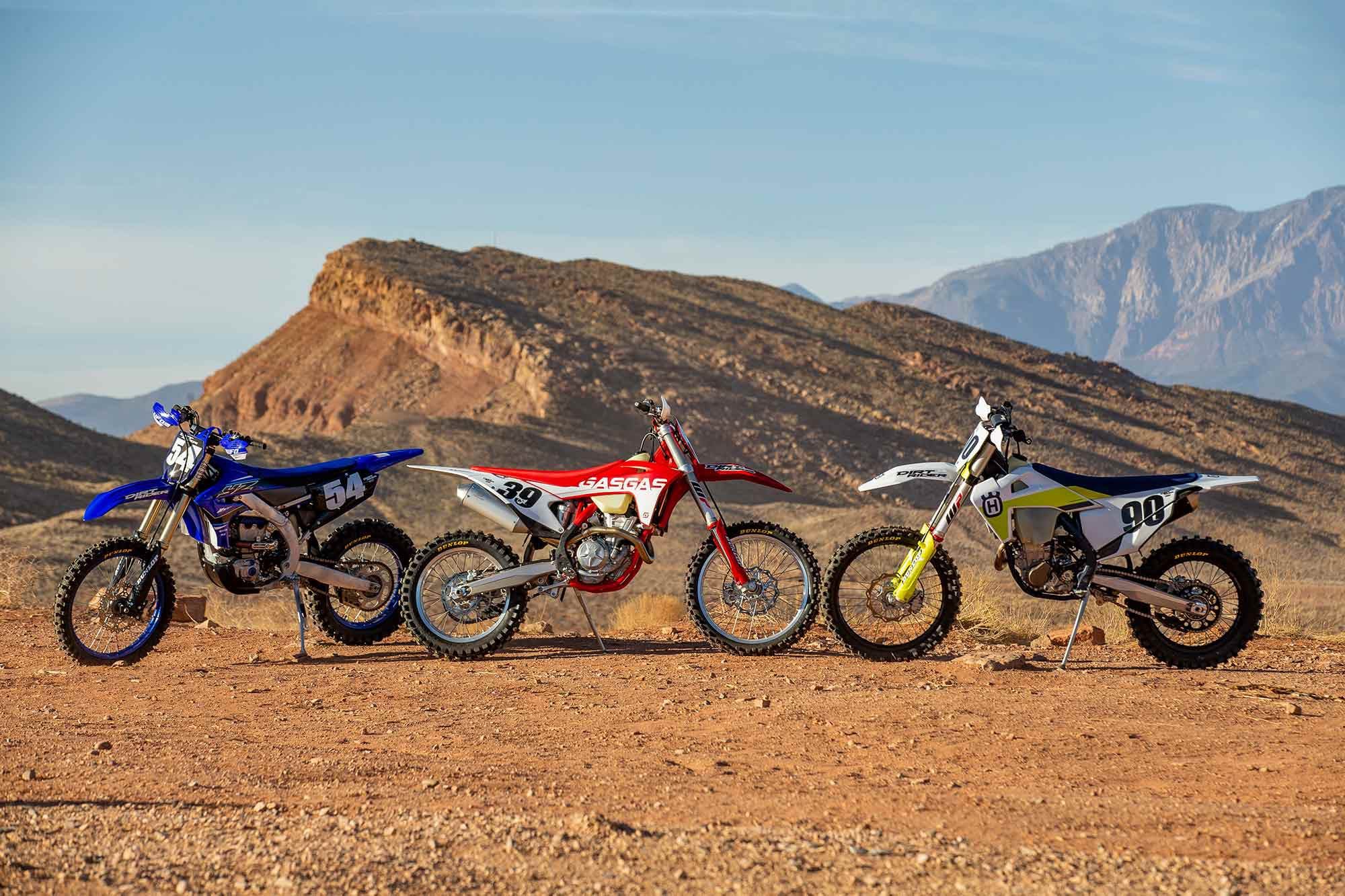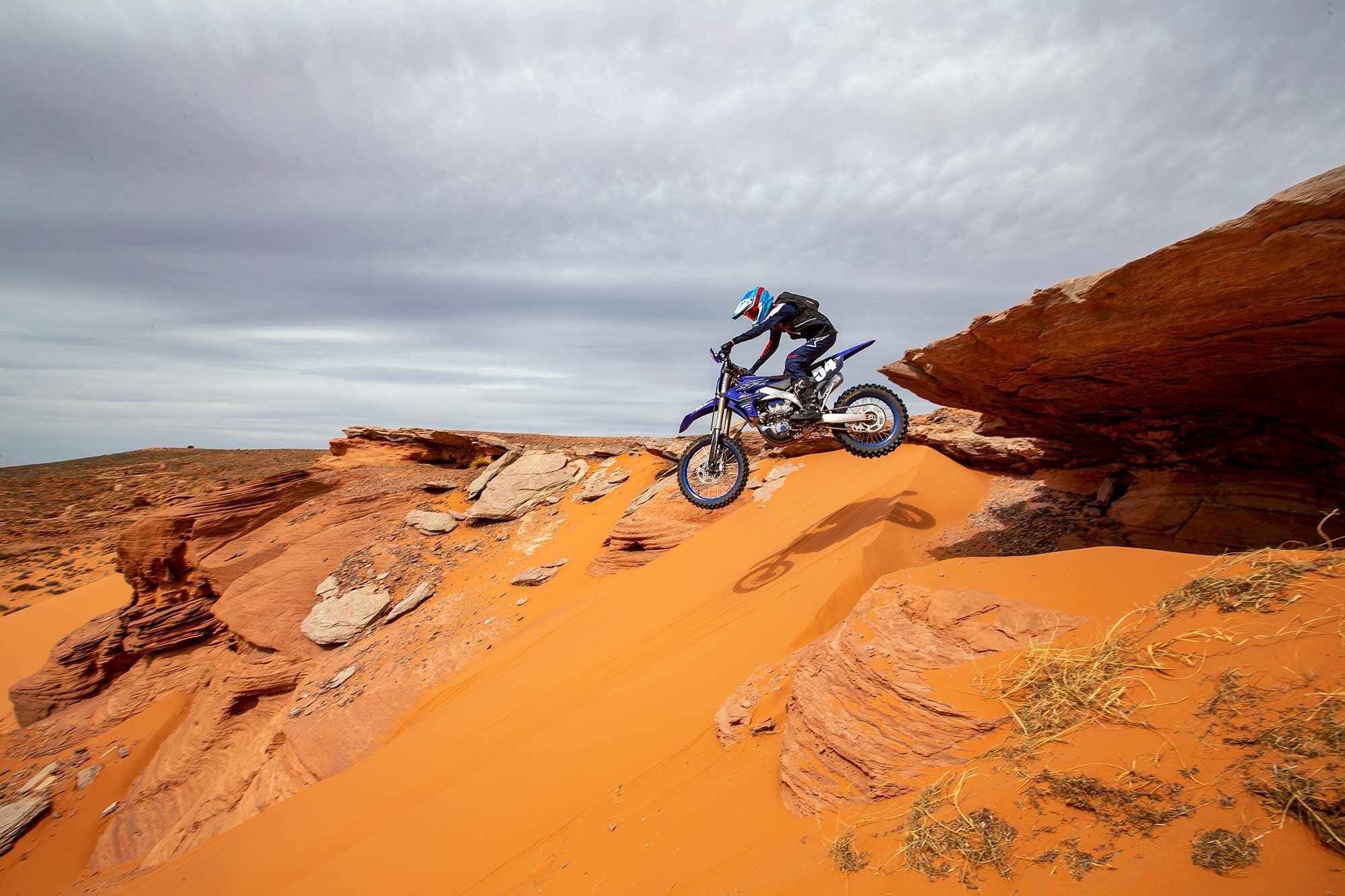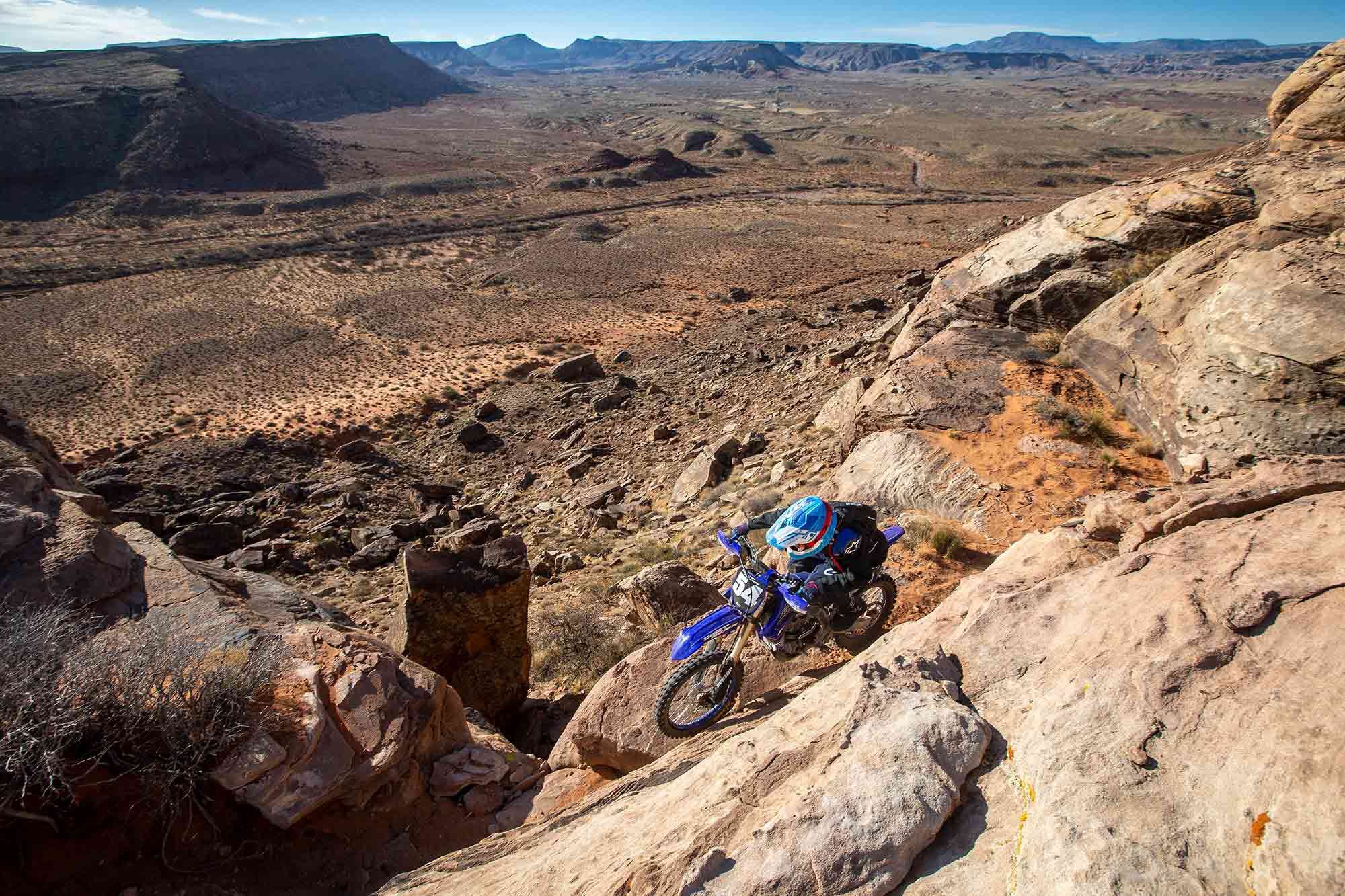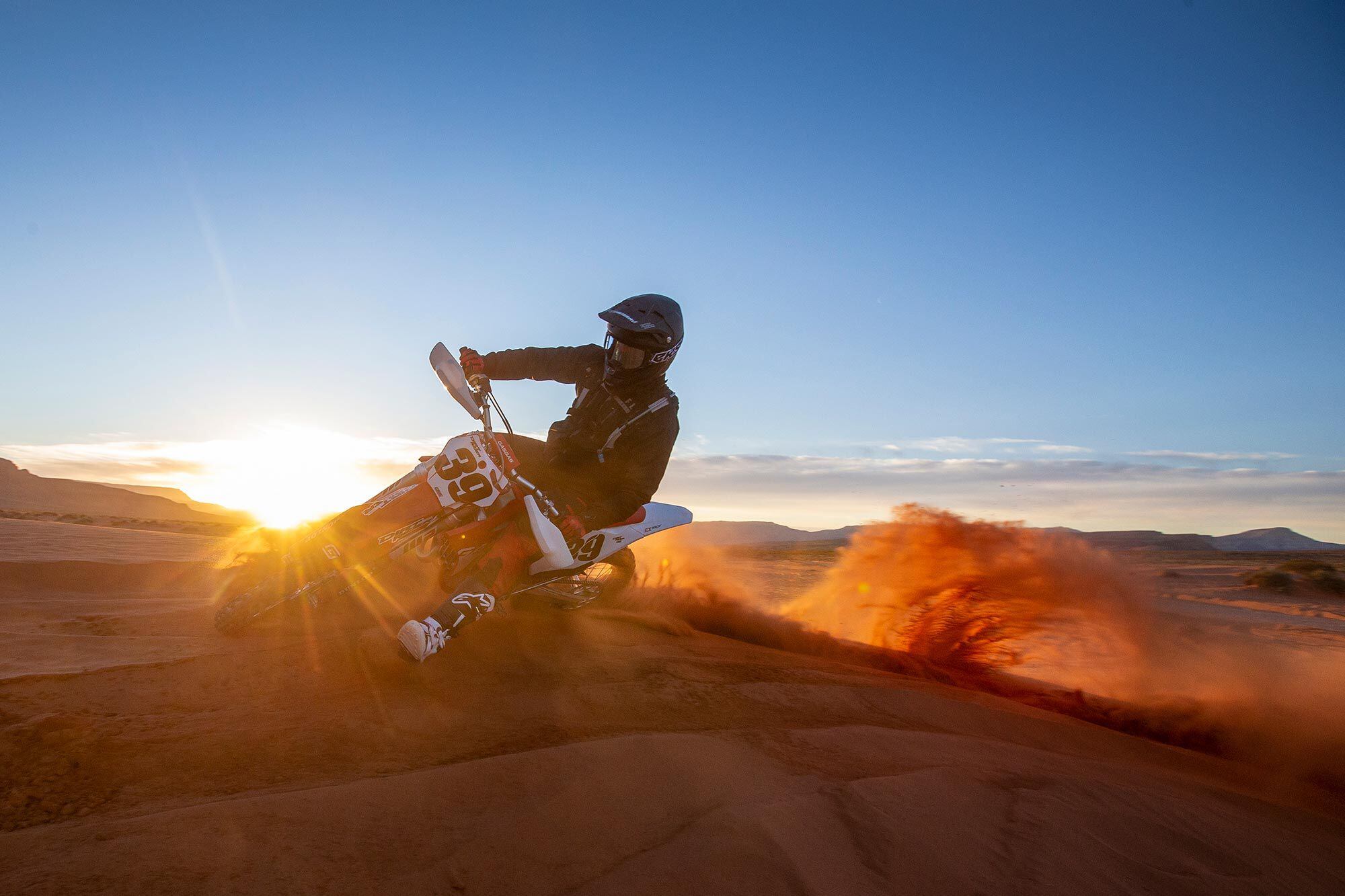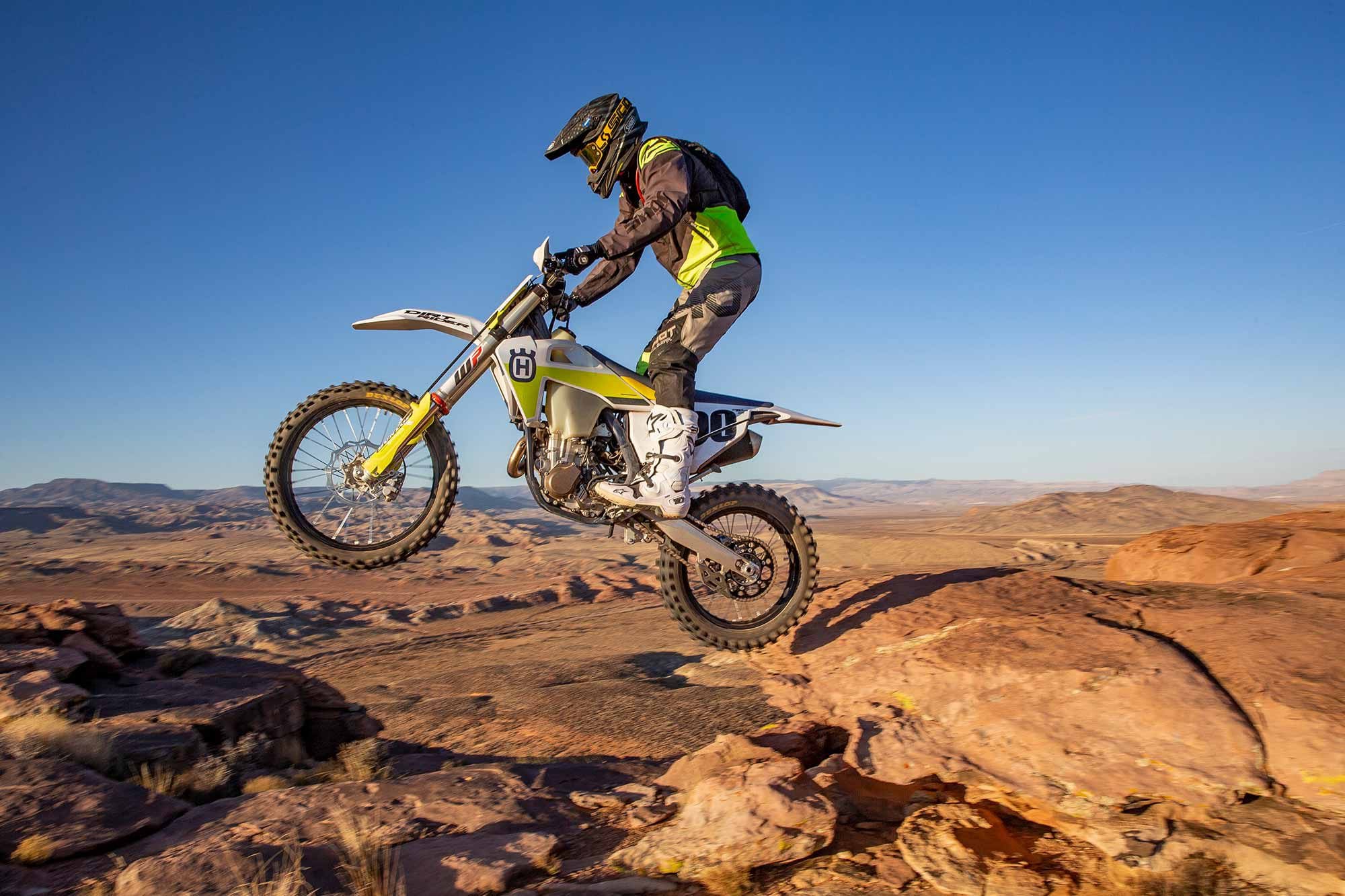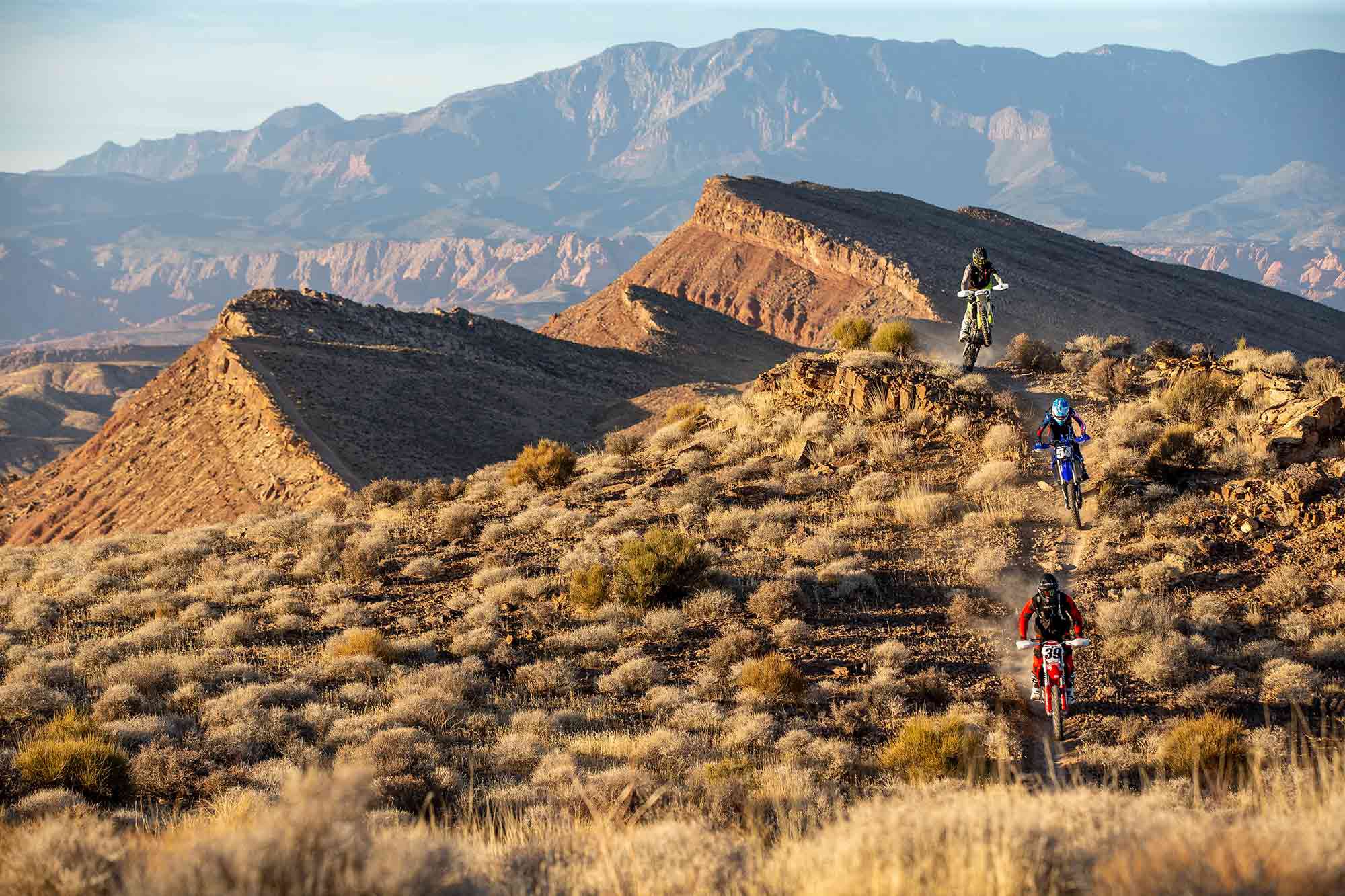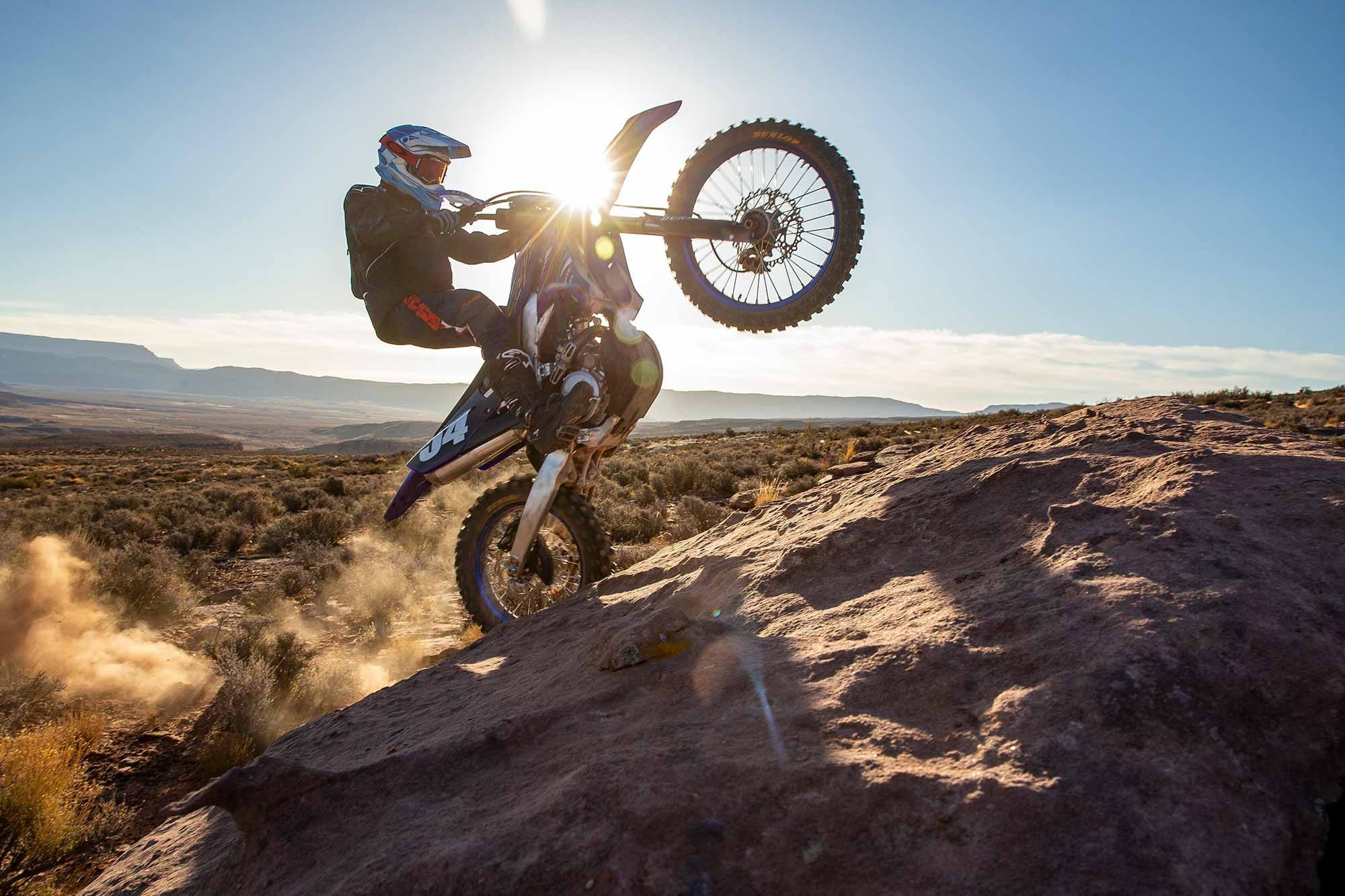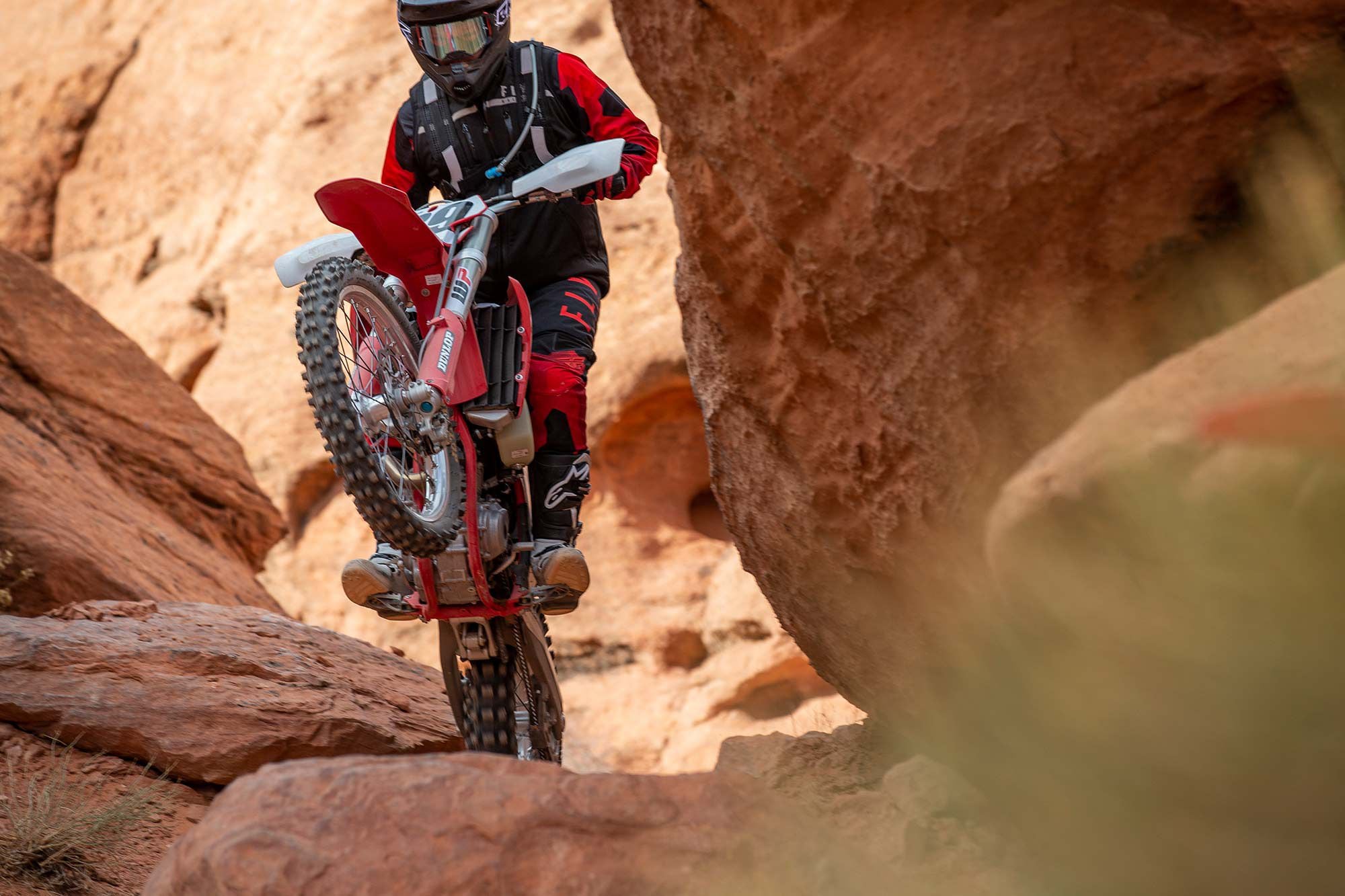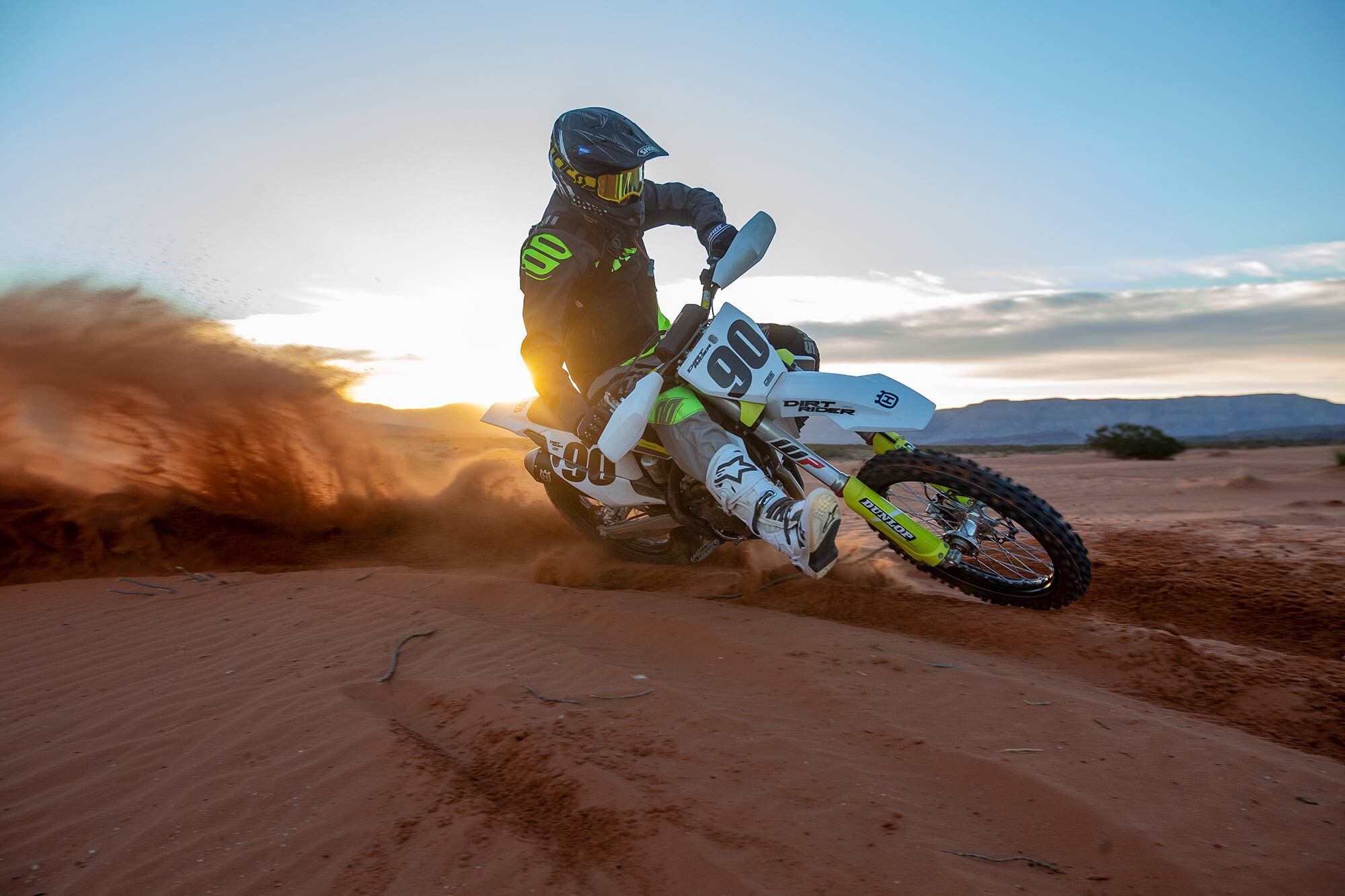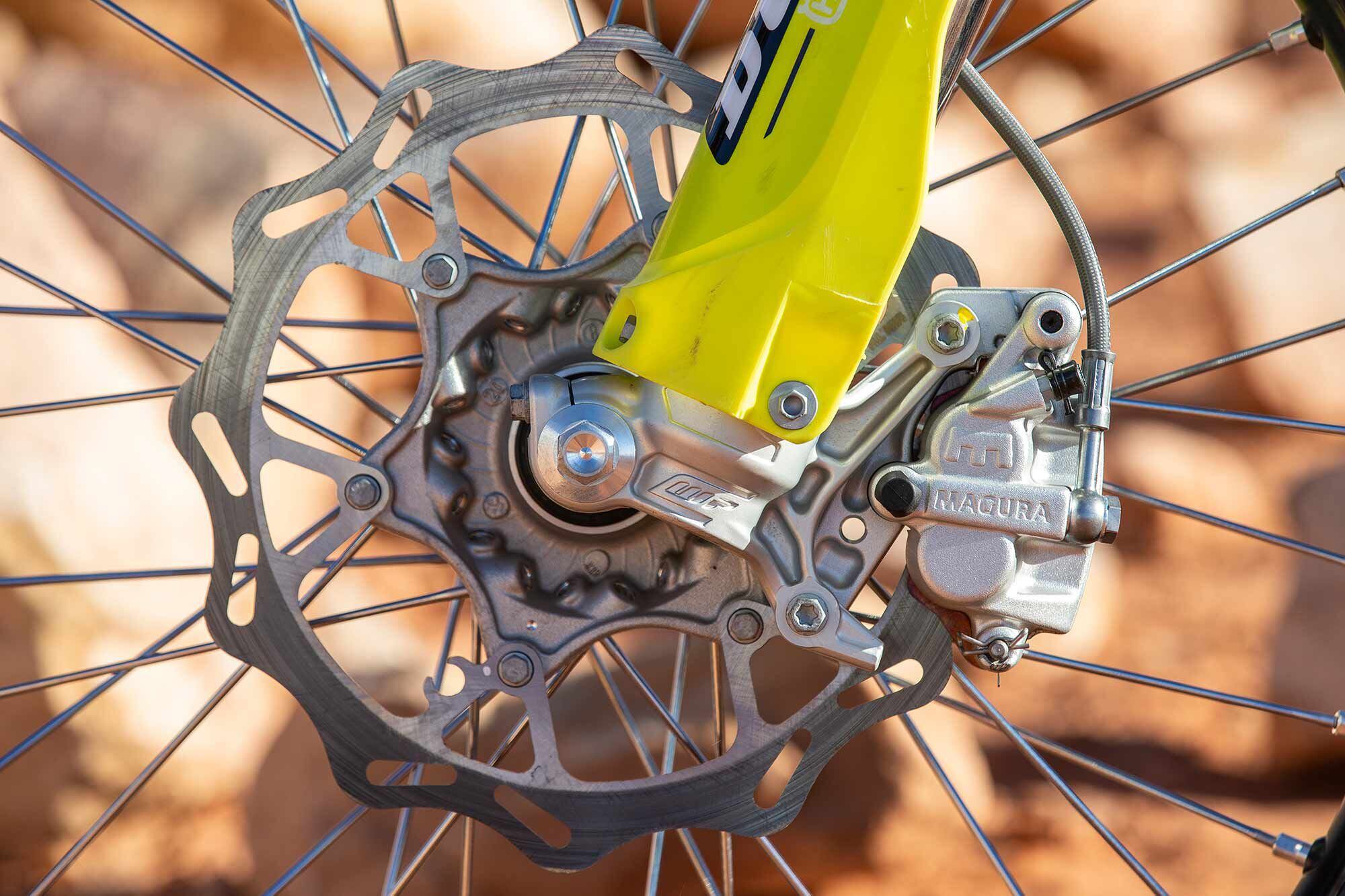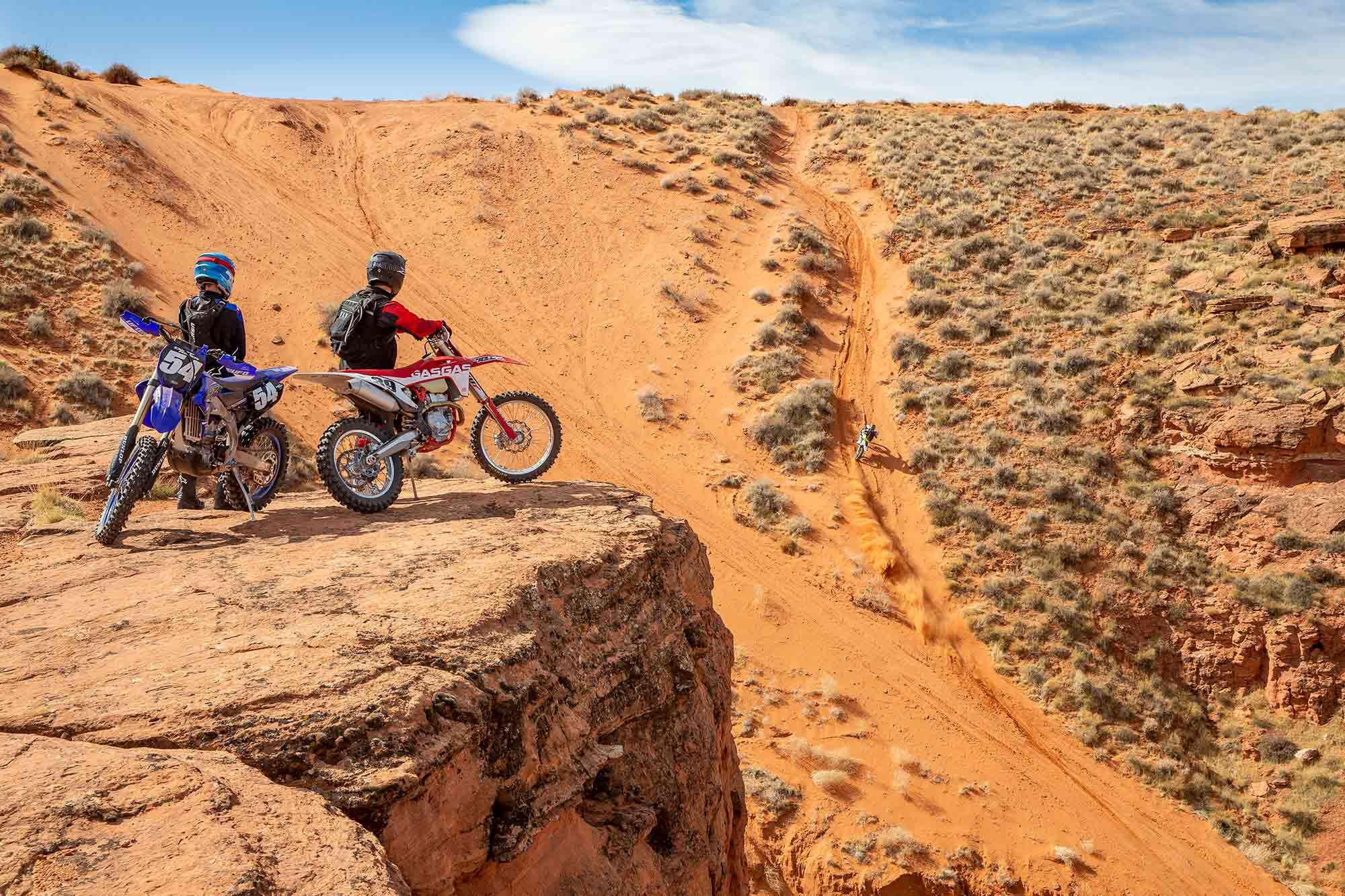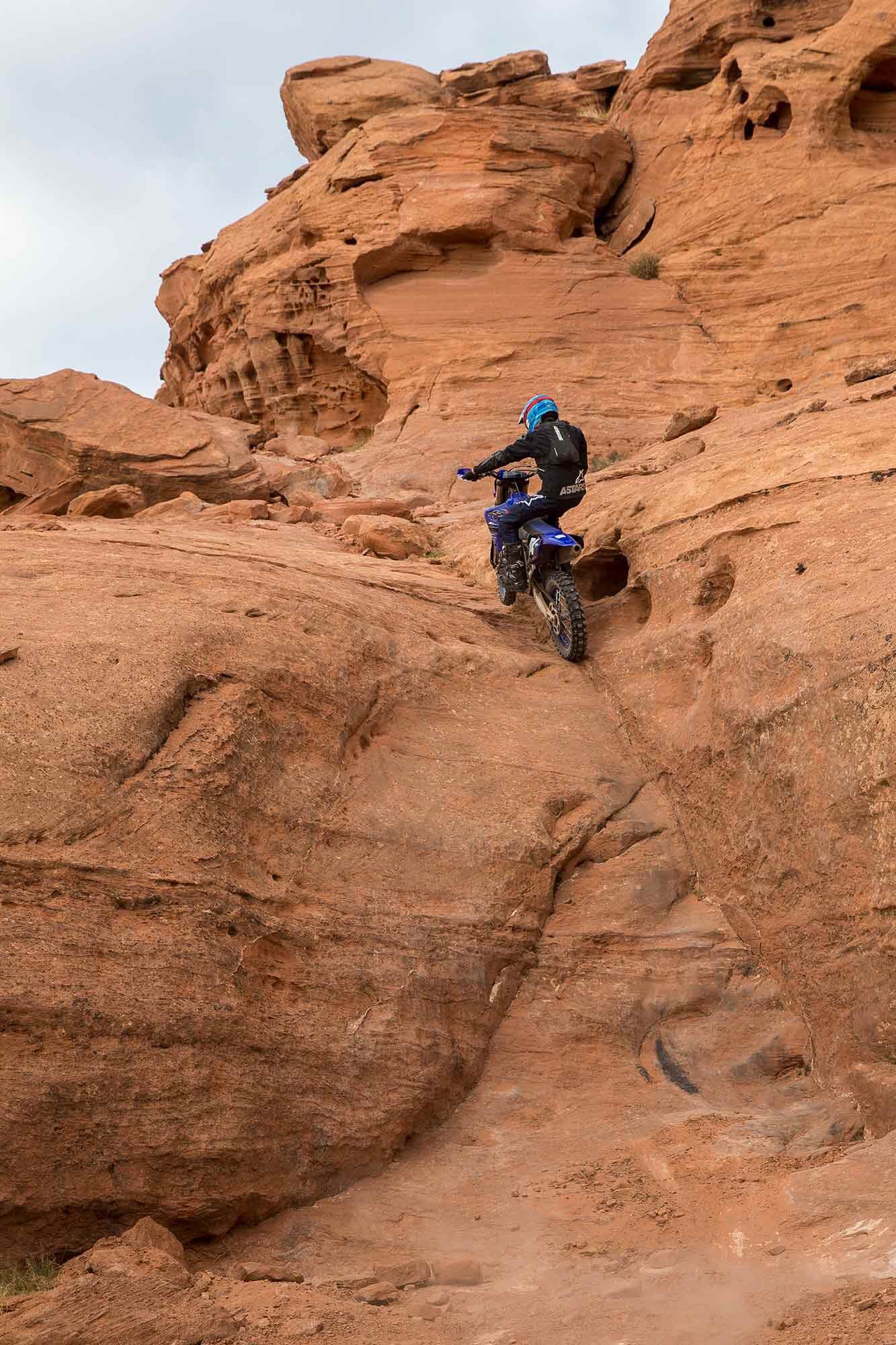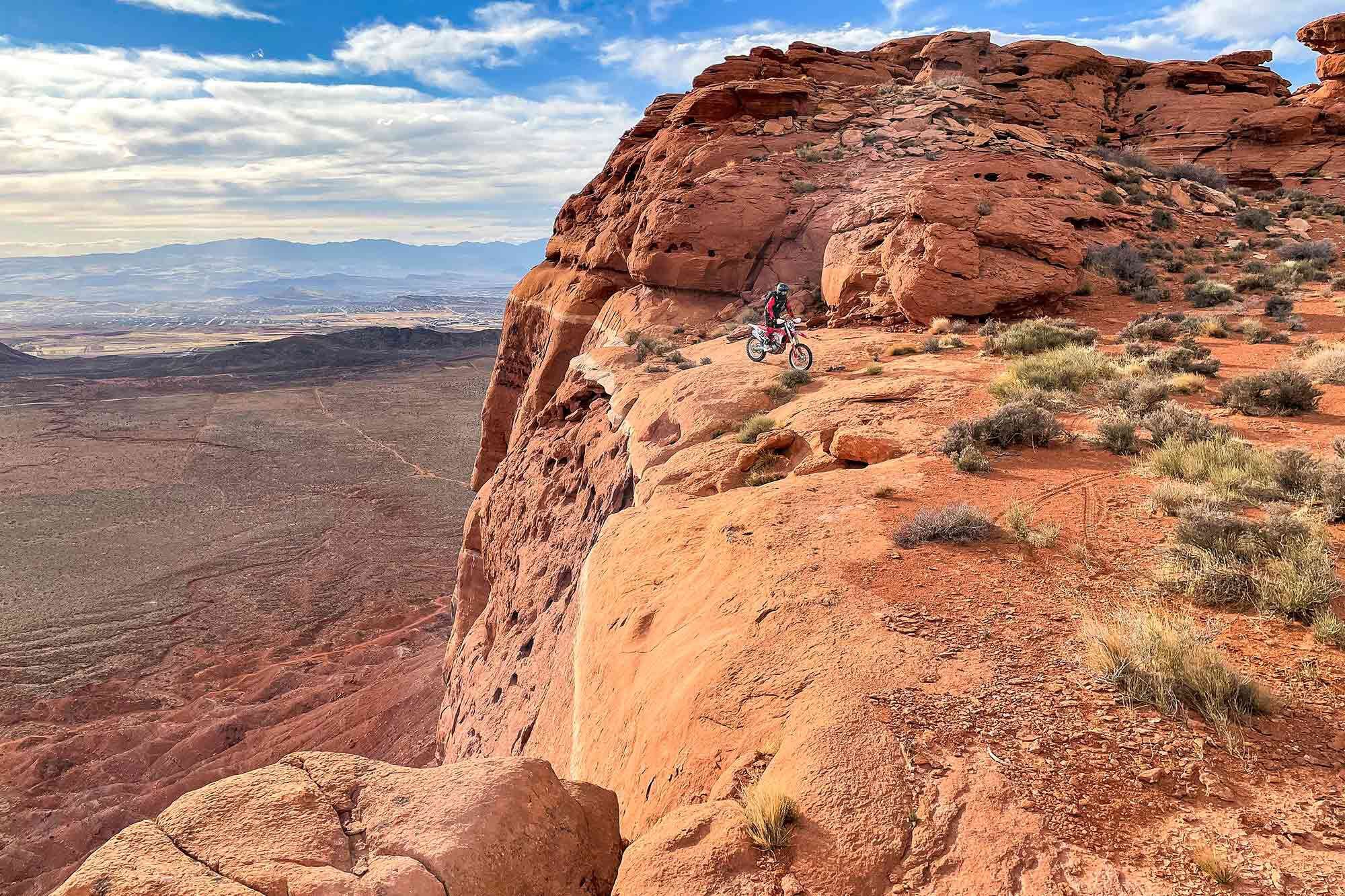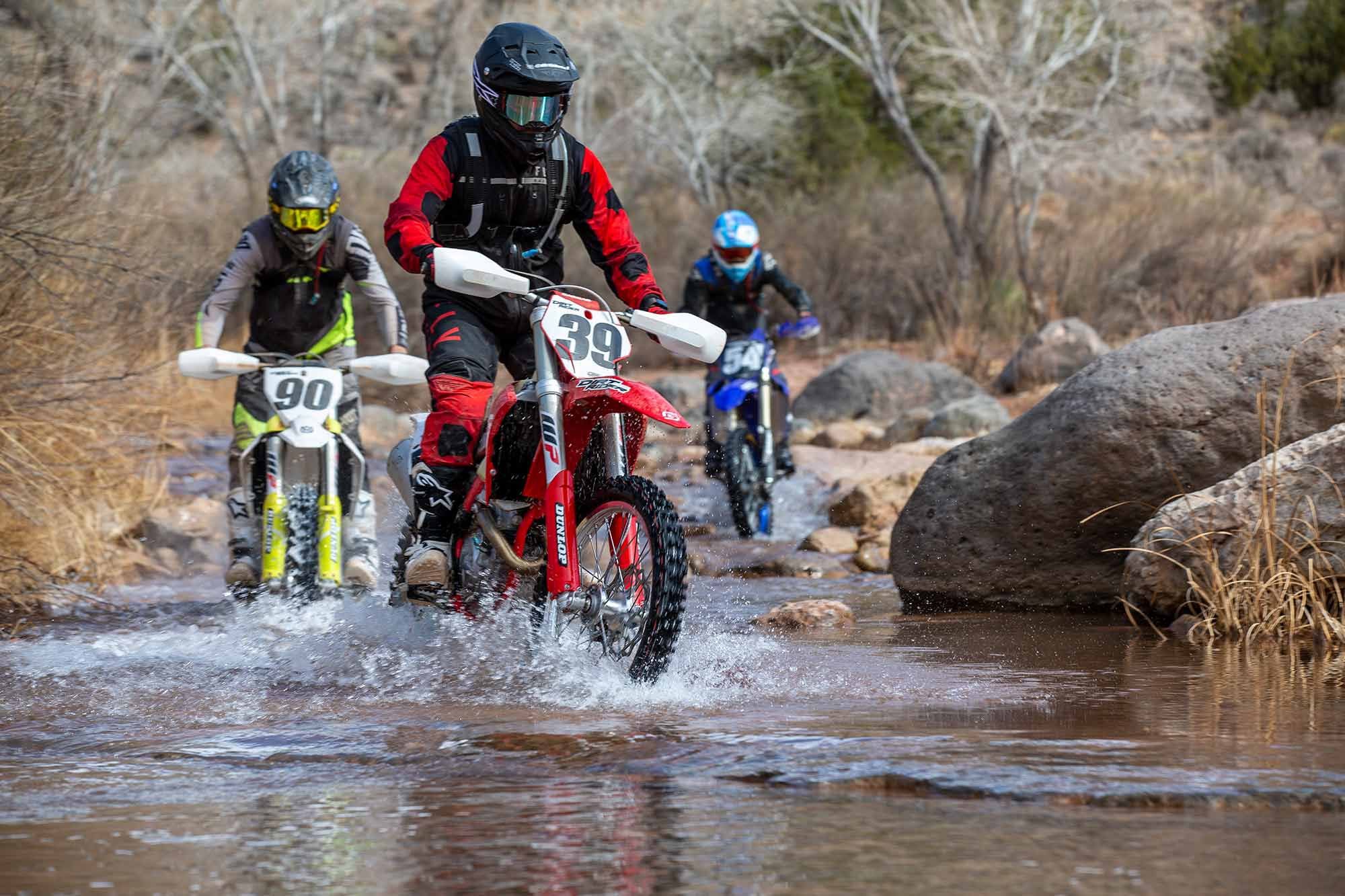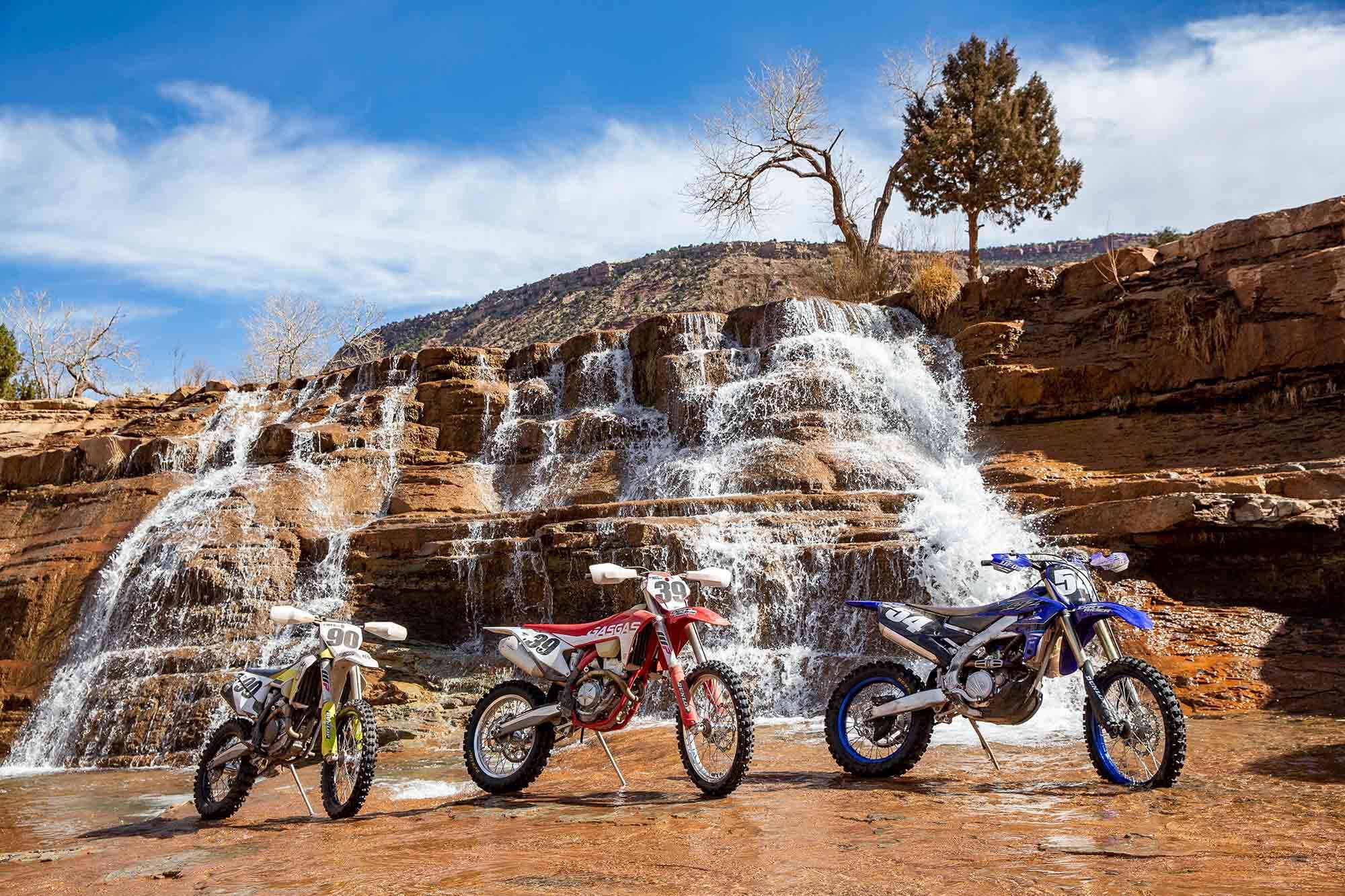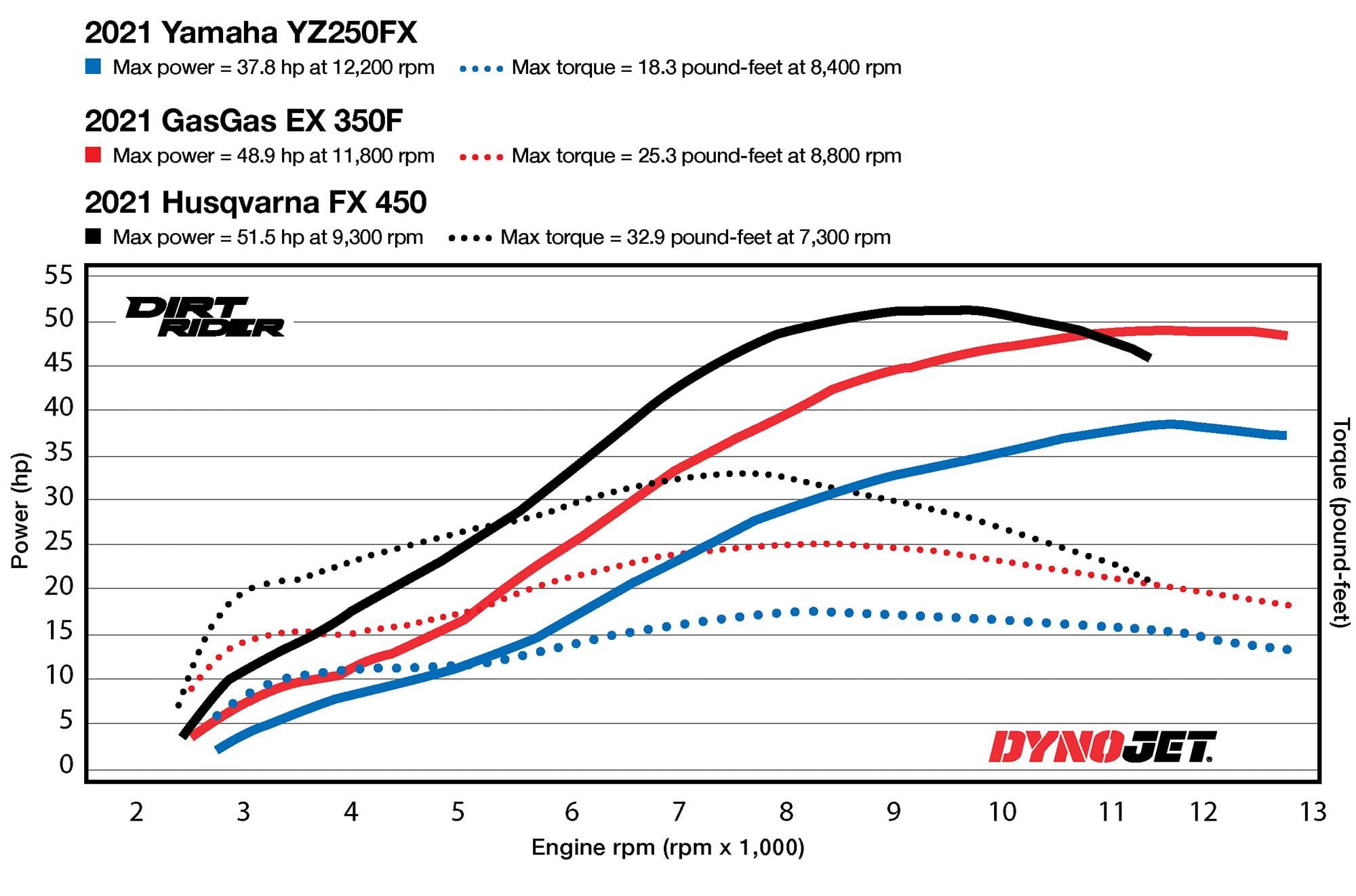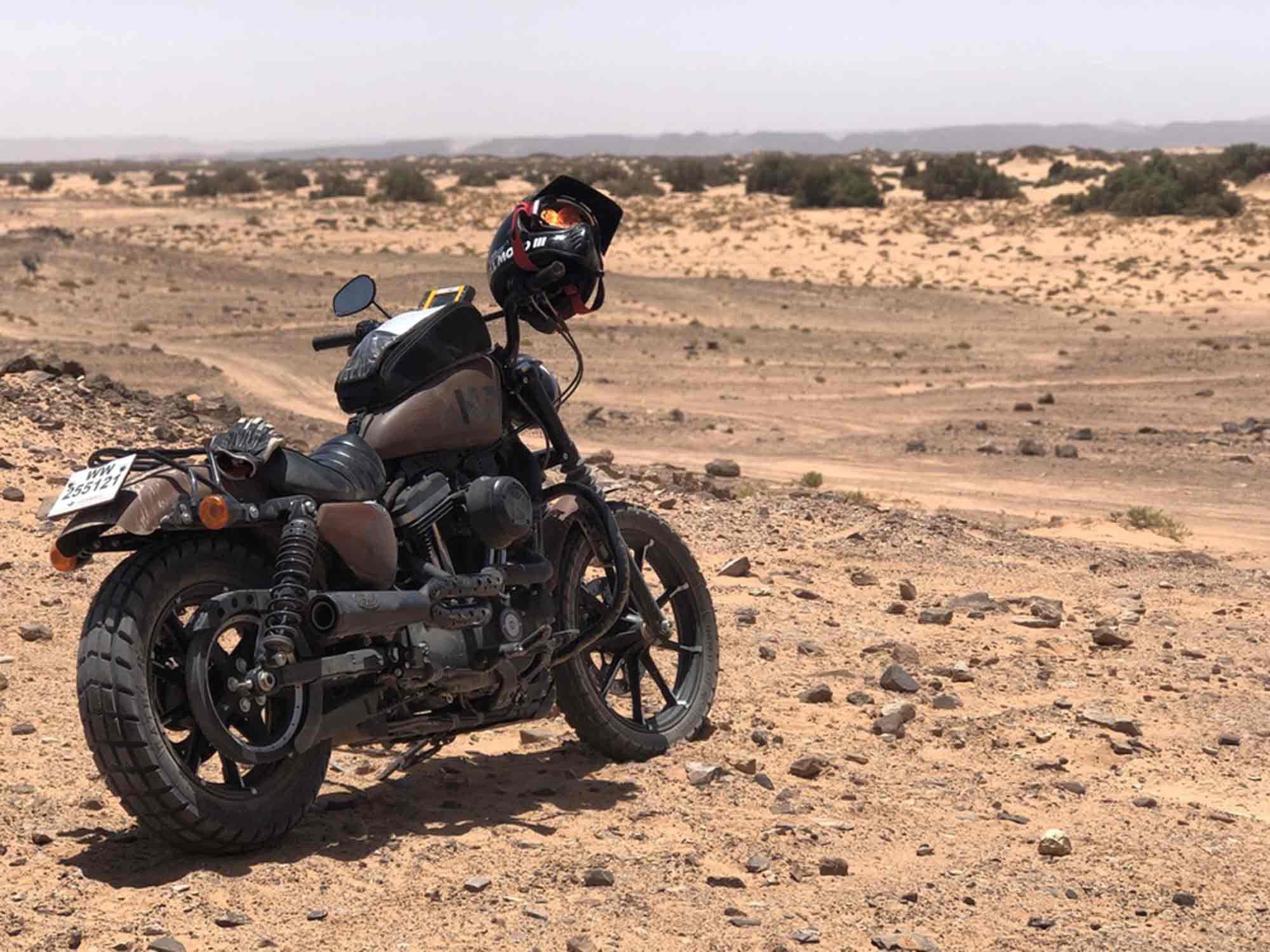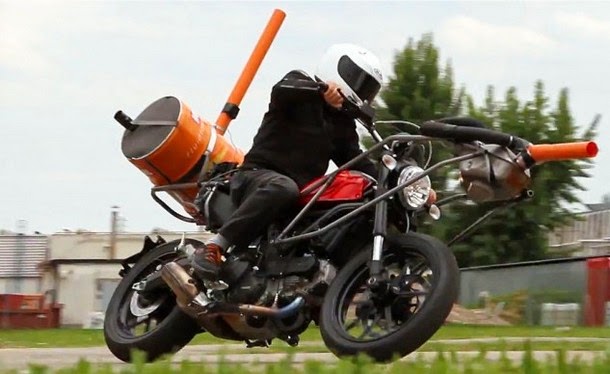Cross-country dirt bikes are awesome because they combine the best qualities of ripping motocrossers with the go-far features of enduro bikes. You get all that moto-winning power, large fuel tanks allowing for longer rides, hand guards to keep the brush at bay, skid plates to protect the undercarriage, and kickstands so you don’t have to find the nearest tree or lift the motorcycle onto a stand while parking them. Some models even have different gearing and wide-ratio transmissions to further increase their off-road capabilities. Rock crawling to wide-open desert blasting, these are the bikes to have. And you’re spoiled for displacement choice: the 250 and 450cc classes are stacked with models from all the major manufacturers, while KTM, Husqvarna, and GasGas each offer a 350cc four-stroke cross-country model.
How do 250cc, 350cc, and 450cc four-stroke off-road competition motorcycles stack up against each other? We made the trek to Utah to find out. (Jeff Allen/)250 vs. 350 vs. 450 Dirt Bike
What are the positives and negatives of each engine size? How do they compare in terms of versatility? Which displacement is best for all-around dirt bike riding? We took the 2021 Husqvarna FX 450, 2021 Yamaha YZ250FX, and 2021 GasGas EX 350F to Utah to find out. Technical trails, red rocks, long hill climbs, and sandy terrain provided everything from clutch-abusing first-gear single-track all the way up to Dakar Rally-esque fifth- and sixth-gear wide-open screaming.
Cliffside. Stay on the trail. (Jeff Allen/)All three bikes feature Dunlop tires in stock trim, the FX 450 and EX 350F on Geomax AT81 rubber and the YZ250FX on Geomax MX3S. Dunlop provided us with new tires for the trio, retaining the stock types and sizes. Only the FX 450 has hand guards stock, so we added sets to the EX 350F and YZ250FX. DeCal Works preprinted number plate backgrounds were applied to each machine.
Fresh Dunlop tires on all of the bikes? Check. (Jeff Allen/)Our group included intermediate, expert, and professional test riders. Ty Cullins has won more than 20 youth motorcycle trials championships; competed at the 2015 X Games; finished eighth in last year’s AMA EnduroCross Championship and third in last year’s FIM SuperEnduro Junior World Championship; and captured three AMA EnduroCross Junior titles. Longtime project bike builder and all-around industry veteran Jay Clark and his son Spencer are hardcore dirt riders with broad experience. We also conducted additional test days with Allan Brown, a regular writer/test rider for dirtrider.com whose past work includes serving as a pro Supercross and motocross technician, engine builder, team manager, and even a team owner. Brown certainly knows his way around the controls as well, having achieved two Grand National Cross Country (GNCC) championships in his age group in 2016 and 2019. Rounding out the crew was Casey Casper, a 30+ A class racer, who offered his insight during local testing.
The FX 450 is easy on the ears thanks to its exhaust system and closed-off airbox. (Jeff Allen/)2021 Yamaha YZ250FX vs. 2021 Husqvarna FX 450 vs. 2021 GasGas EX 350F Engine Power and Tunability
Right from the first run through the gears across the red-sand desert we were reminded just how fast and powerful a 450cc four-stroke dirt bike can be. Even with an abundance of power, the FX 450′s broad, linear delivery is totally manageable by 450 standards. It puts power to the ground in a smooth, calculated, and predictable manner, and is more than capable of being lugged around in a rather lazy fashion. This pays dividends when you’re snaking up a tight trail with boundaries dictated by massive red rock formations on all sides. In fact, it’s best to maintain low rpm in technical sections to prevent wearing yourself out, as the FX 450 is a lot of bike to handle, and it can get away from you if you’re not precise with the throttle. With that seemingly endless top-end power, 51.5 hp as measured on our in-house dyno, the FX 450 laid waste to all of the long, sandy climbs we pointed it at.
Although it offers gobs of power, the Husqvarna FX 450 is ultracontrollable thanks to its linear power delivery, which helps make it manageable in technical scenarios. (Jeff Allen/)In terms of engine tunability, the FX 450 falls somewhere between the EX 350F, which has none in stock trim, and the YZ250FX, with its dual-map switch and its capability to create custom uploadable maps with the Power Tuner app. This can even be done if you’re miles away from civilization in the Utah desert. The FX 450 features a switch allowing the rider to toggle between two maps and traction control, which can be used in either map. The maps are fairly similar, though map 2 increases low-end torque slightly. Traction control does a sufficient job of preventing wheelspin throughout the rpm range, and does its work without too much interference with drive.
Engine vibration is one of the few downsides of the FX 450 powerplant. (Jeff Allen/)Shortcomings of the FX 450 powerplant are few, but certainly noticeable: Engine vibration hits the rider’s hands and feet strongly, and the bike is not as free-revving as the EX 350F or YZ250FX. Without a sixth gear, the FX 450′s five-speed transmission gives the bike more of a motocrosser feeling, and its first gear is not low enough to tame it in tight trails. Multiple test riders also had issues with the bike flaming out and stalling in technical areas. “The Husqvarna’s clutch feel was good by way of the Magura master cylinder,” Cullins said. “However, it stalls easier than any other bike I’ve ridden.”
“The Husqvarna’s clutch feel was good by way of the Magura master cylinder. However, it stalls easier than any other bike I’ve ridden.” —Ty Cullins (Jeff Allen/)At the other end of the displacement spectrum, the YZ250FX’s charms mask its smaller engine and the resulting deficit in horsepower and torque versus the larger-displacement bikes. Thanks to its excellent ECU mapping, the YZ250FX excels at part-throttle openings, delivering crisp, instantaneous response. Coupled with an impressive amount of torque for a 250F, these qualities give it a quick and snappy feel at low rpm, making it easy to loft the front end at a moment’s notice and enabling the bike to thrive in tight, technical areas, such as the creek beds leading up to Toquerville Falls.
The YZ250FX has used Yamaha’s reverse cylinder head design since it was introduced in 2015. The engine configuration plays a major role in making the 250 four-stroke cross-country racer feel so powerful. (Jeff Allen/)But most significantly, if the YZ250FX lacks sheer horsepower and torque compared to the EX 350F and FX 450, it makes up for it in rideability. Traction is easier to find and throttle control is not as big an issue, especially in comparison to the FX 450. Its wide-ratio six-speed transmission’s gear ratios are well-spaced, with a superlow first gear for crawling through the most technical of sections, second and third gears more than capable of handling faster, more flowing trails, and fourth through sixth for when the trail opens up and the speeds increase on two-track and fire roads overlooking the city of Hurricane.
With its smaller-displacement engine and planted suspension, the YZ250FX excels at finding traction. (Jeff Allen/)The YZ250FX also carries an advantage over its competitors in engine tunability. Adjustments to fuel delivery and ignition timing can be made with Yamaha’s free Power Tuner app, an iOS- and Android-based smartphone application which works via the bike’s onboard Wi-Fi. Power delivery changes are quite noticeable. Yamaha offers several preconfigured maps on its website; these can be downloaded directly to a smartphone and uploaded to the bike through the app. One of our favorite maps for the YZ250FX is the Over-rev Map, which provides a slightly broader delivery with longer pulling power up top.
One of the YZ250FX’s only weaknesses is that it doesn’t pull as far in the rpm range as the EX 350F and FX 450. (Jeff Allen/)But even when you map it for Over-rev, it still doesn’t pull quite as far into the upper rpm range as the EX 350F and FX 450. Combined with its smaller displacement, the YZ250FX is less able to to keep driving forward on long, steep, sandy hill climbs. More top-end power would be preferable, but it’s understandable that you have to give to get, and the YZ250FX’s stout low-end-to-midrange performance and excellent torque throughout the rpm range is an acceptable trade for a little less top-end pull.
The bLU cRU’s 250F cross-country racer is the only bike in this comparison to have a cable-actuated clutch. It boasts an easy pull, but is susceptible to fading when used heavily. (Jeff Allen/)Another aspect of the YZ250FX with room for improvement is its starting behavior. It’s less of an issue when the bike is cold, but once warmed up the bike can take three to four clicks of the button before firing to life when in gear. Shifting into neutral helps, but we have to imagine you’d be rolling the dice on getting a holeshot in a race employing a dead-engine start. Finally, the YZ250FX is the only bike here that comes with a cable clutch. Although it works well, with an easy pull, it can heat up and fade a little under heavy use, unlike the hydraulic units on the Austrian machines.
A 350cc four-stroke dirt bike is like a 250F on steroids. (Jeff Allen/)Splitting the difference is not only an effective negotiation tactic; it also pays dividends in providing just the right amount of power from a four-stroke dirt bike engine. Although the EX 350F’s power delivery is similar to a 250 four-stroke in the way it builds, it does so with added torque at low rpm. This makes it less prone to falling off the pipe or even stalling, and allows for better rpm recovery when too tall a gear is selected. After ripping through a strong midrange, the bike transitions seamlessly into higher rpm; just when you think it’s going to sign off, it keeps going. Tons of top-end and over-rev enable the EX 350F powerplant to rev to the moon and pull all the way there. The EX 350F produces only 2.6 peak horsepower less than the FX 450 despite its 100cc disadvantage, and it doesn’t give up much in terms of hill-climbing capability compared to the larger-displacement Austrian machine.
Although the GasGas EX 350F shares most of its parts with the KTM 350 XC-F, it does feature a few Husqvarna items including the swingarm. (Jeff Allen/)Throttle control is only marginally demanding thanks to the EX 350F’s ultralinear delivery, while its quick-revving and light-feeling engine character make it that much more fun to ride. Unlike the FX 450, the GasGas has hardly any detectable engine-braking; its six-speed transmission further increases its already remarkable versatility on the trail. Perhaps the biggest advantage of the 350cc engine is that it makes much more power than a 250F but has less rotating engine inertia than a 450; the extra flywheel and weight tend to give 450s a less agile feel.
The EX 350F is a perfect middle ground for those who yearn for more power than what a quarter-liter engine can offer but don’t want the arm-jerking hit and pull of a 450. (Jeff Allen/)Unlike the FX 450 and YZ250FX, the EX 350F does not come with an engine map switch. However, it’s worth noting that the same unit that comes on the KTM and Husqvarna four-stroke motocross and cross-country models can be purchased through GasGas Technical Accessories for approximately $170. It simply plugs into the harness and is ready to go. As far as the red Austrian bike’s clutch, test riders had nothing but positive things to say about the Brembo hydraulic unit, citing its smooth pull, predictable actuation, and resistance to fade.
Yamaha has stuck with a tried-and-true coil-spring fork on its dirt bikes over the years, while GasGas’ and Husqvarna’s motocross and cross-country models use an air fork. (Jeff Allen/)2021 Yamaha YZ250FX vs. 2021 Husqvarna FX 450 vs. 2021 GasGas EX 350F Suspension
A bike will only go as fast as the rider is able and willing to push it, and much of that has to do with the suspension. The GasGas and Husqvarna share the same WP Xact air fork and WP Xact shock, while the Yamaha uses a KYB Speed Sensitive System (SSS) fork and KYB shock.
Small bumps, large G-outs, jump landings, drop-offs; it doesn’t matter what you throw at the YZ250FX, its KYB suspension handles it all with a remarkable balance of plushness and performance. (Jeff Allen/)Simply put, the YZ250FX’s KYB components are the gold standard of stock dirt bike suspension, and Yamaha deserves praise for nailing setup. The YZ250FX has a near-perfect balance of performance and plushness, though leaning just slightly more toward the former. The remarkable amount of progressive action throughout the stroke at both ends allows the YZ250FX to soak up the largest rollers while still offering impressive comfort in the rocks. Whether you’re tackling low-speed technical trails or slamming through seemingly endless whoop-ridden straightaways, the YZ250FX’s suspension handles it all without missing a beat. When we mistimed the occasional roller and consequently got out of rhythm while traversing Utah’s vast expanse of red-sand desert, the Yamaha’s suspension was the most confidence-inspiring.
“Of the three bikes, the YZ250FX has the most race-orientated suspension settings.” —Allan Brown (Jeff Allen/)Rider weight hardly plays a factor in preference for the YZ250FX suspension. Despite being set up for a smaller-displacement bike and, accordingly, a lighter rider, the Yamaha drew the most praise from every test rider, from our 125-pound bantamweight to our 205-pound heavyweight. Brown’s 175 pounds are a bit closer to the upper end of the recommended weight range for a stock 250F suspension setup, but only minor clicker changes were needed to dial in an ideal setting for him. “Of the three bikes, the YZ250FX has the most race-orientated settings,” he said. “At first, after getting off the EX 350F and FX 450, it was almost too stiff. Some small adjustments [two clicks out on the compression front and rear] were all it needed to get just a little more comfort out of it.”
The EX 350F isn’t the most predictable at speed, but that has more to do with the suspension than the chassis. (Jeff Allen/)While the blue bike’s suspension excels in whatever gets thrown at it, the WP Xact units on the GasGas have their strengths and weaknesses. Although the components are fairly balanced, they are best suited for lower-speed single-track riding. There, they offer plenty of comfort and stay high in the stroke when tackling small obstacles, but also squat and offer an impressive amount of traction under acceleration.
But the GasGas’s springy feeling, compared to the YZ250FX and FX 450, makes the red Austrian machine less planted, especially at speed. Additional rider input is necessary to help keep the bike under control when encountering high-speed rollers, as well as the inevitable G-outs created by throngs of OHV enthusiasts who also made the trek to Utah to experience the Beehive State’s epic terrain and scenery. Adjustments help, for instance stiffening the shock’s high-speed compression and rebound, but the sensation is still noticeable regardless of settings. Spencer Clark echoed the sentiments of other test riders in that the suspension was his only major criticism of the GasGas. “At low speeds, the fork really soaks it all up,” he said, “but higher speeds can lead to feelings of it spiking or diving.”
“With more power, the suspension becomes even more critical, and the FX 450 worked OK, just not great. It was also the only bike I bottomed the shock on.” —Casey Casper (Jeff Allen/)The FX 450 shares the same WP Xact components as the EX 350F, but its settings deliver a slightly different feel on the trail. The suspension has a reasonably planted feeling due to its softer settings, yet has enough rebound control to be predictable under heavier loads. The rear of the bike feels relatively low, giving it a bit of a chopper stance and creating a slightly unbalanced feeling. Stiffening the shock helps reduce this sensation, which is easy for riders to get accustomed to after about half an hour of riding; that span of time may be slightly reduced if you’re busy being taken in by incredible scenery. “With more power, the suspension becomes even more critical, and the FX 450 worked OK, just not great,” Casper said. “It was also the only bike I bottomed the shock on.”
In addition to a bike’s chassis design and suspension setup, engine size plays a significant role in how it handles too. (Jeff Allen/)2021 Yamaha YZ250FX vs. 2021 Husqvarna FX 450 vs. 2021 GasGas EX 350F Chassis/Handling
With different amounts of rotating mass between the three bikes, handling was interesting to decipher. This was especially true between the EX 350F and FX 450, which share the same frame and swingarm but possess different subframe materials; aluminum for the GasGas and composite carbon fiber for the Husqvarna. Despite having the smallest engine, the YZ250FX is the heaviest at 246 pounds, compared to the FX 450 at 240 and the EX 350F at 237. The Yamaha’s additional weight over the Austrians is not all that apparent while riding; if anything, it shows more in the bike’s extremely planted feeling, due to its phenomenal suspension and a chassis design that revolves around the engine’s reversed cylinder head configuration. Even the bike’s extra capacity tank places the additional fuel in a lower point at the rear of the bike to give it this great feel.
Trials-like maneuvers are encouraged while at the controls of the YZ250FX due to its remarkable amount of torque and crisp throttle response. (Jeff Allen/)The Yamaha is rock-solid at speed, yet mostly corners with ease. It takes a little extra effort to lean into turns and maneuver in tight sections due to its stable character, but the bike responds to a reasonable and mostly minimal amount of rider input. One uniquely Yamaha area of the bike is its ergonomics; with a slightly wider radiator shroud area and midsection, pocketed seat, and thin seat foam, the YZ250FX takes some extra time to get used to compared to its Austrian competition. Still, it feels almost completely comfortable after about 10 minutes of riding it for the first time or coming off another brand of bike. The Nissin brakes deliver a remarkably progressive feel, but don’t quite offer the pucker power of the Brembo binders on the GasGas or the Husqvarna’s Magura units.
The EX 350F is the lightest of the three bikes and feels like it on the trail. (Jeff Allen/)Moving up the displacement spectrum, the EX 350F has the lightest feel of the trio and a nimble character. However, its predictability at speed is hampered by the suspension’s tendency to travel too quickly through the stroke. Narrowness from the radiator shroud area to the side number plates facilitates rider movement, while the rider triangle is the best proportioned. Stopping power is provided by Brembo; these are not only the strongest brakes in this comparison test but also the best on the market.
Although not the heaviest bike in this comparison, the FX 450 feels like it is, partially because of the engine’s additional rotating mass compared to the EX 350F and YZ250FX. (Jeff Allen/)Engine size plays a major part in a bike’s mannerisms, and getting a 450′s chassis to handle well and abide a rider’s desires is no easy feat; however, Husqvarna has done an impressive job of doing so. The FX 450 is nimble by 450 standards, if not nearly as responsive to rider input as the YZ250FX or EX 350F. Conversely, its stability when charging in third- to fifth-gear trails is impressive. Despite not being the heaviest bike on the scale, the FX 450 feels like the heftiest of the three in this group. The white Austrian machine’s long wheelbase sensation and slight chopper stance are its other distinct qualities.
The FX 450’s Magura brakes don’t offer quite as much pucker power as the Brembos on the GasGas. But they have more bite than the Yamaha’s Nissin binders. (Jeff Allen/)Ergonomically, the FX 450 has an open, comfortable cockpit providing plenty of room to move around on, complemented by a mostly neutral rider triangle. Although the Husqvarna’s radiator shroud is similar to the EX 350F, its design isn’t quite as sleek as the GasGas’ and its seat doesn’t provide as much grip as the other bikes. The Magura brakes provide slightly less stopping power than the Brembo units on the GasGas, but more bite than the Yamaha’s Nissins.
If there’s one time you envy your buddy riding a 450 while you’re on a smaller-displacement dirt bike, it’s when faced with a long, sandy hill climb. (Jeff Allen/)250 vs. 350 vs. 450 Dirt Bike Positives and Negatives
Naturally, all three bikes have their strengths, and some allow you to do things better and easier than others. Although the FX 450 can be a bit much for single-track, it is not by any means unrideable in such areas. Plus it absolutely hauls the mail in fast desert sections and climbs hills in the blink of an eye. Its capability in fast wide-open terrain is complemented by its stable character. But the FX 450 is not for everyone; the majority of riders best suited to it will have lots of riding experience, ample physical strength, and enjoy the feeling of acceleration, horsepower, and torque without having to push engine rpm.
The little engine that could. If there’s a 250 four-stroke off-road competition bike that has the potential to hang with larger-displacement machines, it’s the YZ250FX. (Jeff Allen/)The YZ250FX proves that you don’t need a large-displacement bike to enjoy tackling just about any terrain. In fact, Yamaha’s potent 250 four-stroke engine makes its smaller displacement less of a factor when selecting a favorite between the trio of machines; its phenomenal suspension, mostly neutral handling, and best engine tuning capability are other reasons to favor it over the Austrians. Considering the YZ250FX’s suggested retail price is $1,500 less than the EX 350F’s and $2,300 under the FX 450′s sweetens the deal even more.
KTM, Husqvarna, and now GasGas have a monopoly on the 350cc four-stroke dirt bike market, which may very well be the perfect engine size for the vast majority of riders. (Jeff Allen/)The EX 350F has a lot going for it. The midsize engine suits the widest range of riders regardless of skill level and weight, and it crosses over between different types of off-road riding the best, giving it the most versatility. You can be lazy or ride it as hard as you’re able without using up a lot of energy, because the engine is powerful but not overpowering. Combining the amazing powerplant with a neutral-handling chassis, agreeable ergonomics, top-of-the-line brakes, and a fantastic clutch makes the EX 350F an even more enticing option.
The EX 350F’s WP Xact air fork absorbs impacts well while riding at low speeds, but is susceptible to spiking and diving when the pace increases. (Jeff Allen/)The bike’s only weakness may be in the eyes of the hardcore rider or racer, because the suspension is set up on the softer side, making it most suited for trail riding. For most of us, though, this will be just fine. After hundreds of Utah miles through some of the most beautiful scenery on earth, and many more back in California on trails we know and love, we found the $9,999 GasGas EX 350F will take more riders more places more easily. Consider it the ultimate in search engine results.
“Depending on the intended usage and type of rider, all of the bikes are winners. Smaller, lighter riders and vets will respond well to the YZ250FX and EX 350F. The FX 450 has a place, but it isn’t in supertechnical trails and likes to be ridden with some space.” —Casey Casper (Jeff Allen/)Gearbox #1
Helmet: Shoei VFX-EVO
Goggle: Scott Fury
Hydration Pack: USWE Ranger 9
Jacket: Shot Race Gear Softshell Lite Enduro
Jersey: Shot Contact Trust
Gloves: Shot Contact Trust
Pants: Shot Contact Trust
Boots: Alpinestars Tech 10
Gearbox #2
Helmet: Fly Racing Formula CC
Goggle: EKS Brand Lucid
Hydration Pack: Fly Racing XC 100
Jacket: Fly Racing Patrol
Jersey: Fly Racing Kinetic K121
Gloves: Fly Racing Kinetic K121
Pants: Fly Racing Kinetic K121
Boots: Alpinestars Tech 7
Gearbox #3
Helmet: Shoei VFX-EVO
Goggle: Oakley Airbrake MX
Hydration Pack: USWE Outlander 4
Jacket: Alpinestars Session Race
Jersey: Alpinestars Techstar Venom
Gloves: Alpinestars Racefend
Pants: Alpinestars Techstar Venom
Boots: Alpinestars Tech 7 Enduro
2021 Yamaha YZ250FX vs. 2021 GasGas EX 350F vs. 2021 Husqvarna FX 450 Dyno Comparison Chart. (Robert Martin/)Specifications:
| 2021 Yamaha YZ250FX | 2021 GasGas EX 350F | 2021 Husqvarna FX 450 | |
| MSRP: | $8,499 | $9,999 | $10,799 |
| Engine: | DOHC, liquid-cooled single-cylinder; 4 valves | DOHC, liquid-cooled single-cylinder | SOHC, liquid-cooled single-cylinder |
| Displacement: | 250cc | 88.0 x 57.5mm | 95.0 x 63.4mm |
| Bore x Stroke: | 77.0 x 53.6mm | 14.2:1 | 12.75:1 |
| Compression Ratio: | 13.8:1 | 350cc | 450cc |
| Transmission/Final Drive: | 6-speed/chain | 6-speed/chain | 5-speed/chain |
| Dirt Rider Measured Horsepower: | 37.8 hp @ 12,200 rpm | 48.9 hp @ 11,800 rpm | 51.5 hp @ 9,300 rpm |
| Dirt Rider Measured Torque: | 18.3 lb.-ft. @ 8,400 rpm | 25.3 lb.-ft. @ 8,800 rpm | 32.9 lb.-ft. @ 7,300 rpm |
| Fuel System: | EFI w/ 44mm throttle body | EFI w/ 44mm throttle body | EFI w/ 44mm throttle body |
| Clutch: | Wet, multiplate; cable actuation | Wet, multiplate, Diaphragm Steel (DS); hydraulic actuation | Wet, multiplate Damped Diaphragm Steel (DDS); hydraulic actuation |
| Frame: | Bilateral beam aluminum | Central double cradle chromoly steel | Central double cradle chromoly steel |
| Front Suspension: | KYB Speed Sensitive System (SSS) coil-spring fork, compression and rebound damping adjustable; 12.2 in. travel | WP Xact 48mm fork, air pressure, compression damping, and rebound damping adjustable; 12.2 in. travel | WP Xact 48mm fork, air pressure, compression damping, and rebound damping adjustable; 12.2 in. travel |
| Rear Suspension: | KYB shock, spring preload, high-/low-speed compression damping, and rebound damping adjustable; 12.5 in. travel | WP Xact shock, spring preload, high-/low-speed compression damping, and rebound damping adjustable; 11.8 in. travel | WP Xact shock, spring preload, high-/low-speed compression damping, and rebound damping adjustable; 11.8 in. travel |
| Front Brake | Nissin 2-piston caliper, 270mm disc | Brembo 2-piston caliper, 260mm disc | Magura 2-piston caliper, 260mm disc |
| Rear Brake: | Nissin 1-piston caliper, 245mm disc | Brembo 1-piston caliper, 220mm disc | Magura 1-piston caliper, 220mm disc |
| Tires, Front/Rear: | Dunlop Geomax MX3S; 80/100-21 / 110/100-18 | Dunlop Geomax AT81; 80/100-21 / 110/100-18 | Dunlop Geomax AT81; 90/90-21 / 110/100-18 |
| Rake/Trail: | 27.2°/4.6 in. | 26.1°/4.9 in. | 26.1°/4.9 in. |
| Wheelbase: | 58.3 in. | 58.5 in. | 58.5 in. |
| Ground Clearance: | 12.6 in. | 14.6 in. | 14.6 in. |
| Dirt Rider Measured Seat Height: | 37.7 in. | 37.7 in. | 37.2 in. |
| Fuel Capacity: | 2.2 gal. | 2.25 gal. | 2.25 gal. |
| Dirt Rider Measured Wet Weight: | 246 lb. | 237 lb. | 240 lb. |
| Availability: | Now | Now | Now |
| Contact: | yamahamotorsports.com | gasgas.com | husqvarna-motorcycles.com |


